Shinn Fund Recipients
Recipients of the Tom and Bruce Shinn Fund have conducted research on a wide array of native plant related topics. Since 2013, over 45 undergraduate and graduate students from eight universities across the state have received funds for their research projects. Their studies have taken them to remote rocky outcrops and cliff faces, rugged mountain terrain, piedmont forests and prairies, open salt marshes, swamps, and marshy coastal plains. Steamy summer days, pesky insects, long hours, and heavy backpacks have not deterred their enthusiasm for research. Results of their studies have added to our knowledge of North Carolina’s native flora.
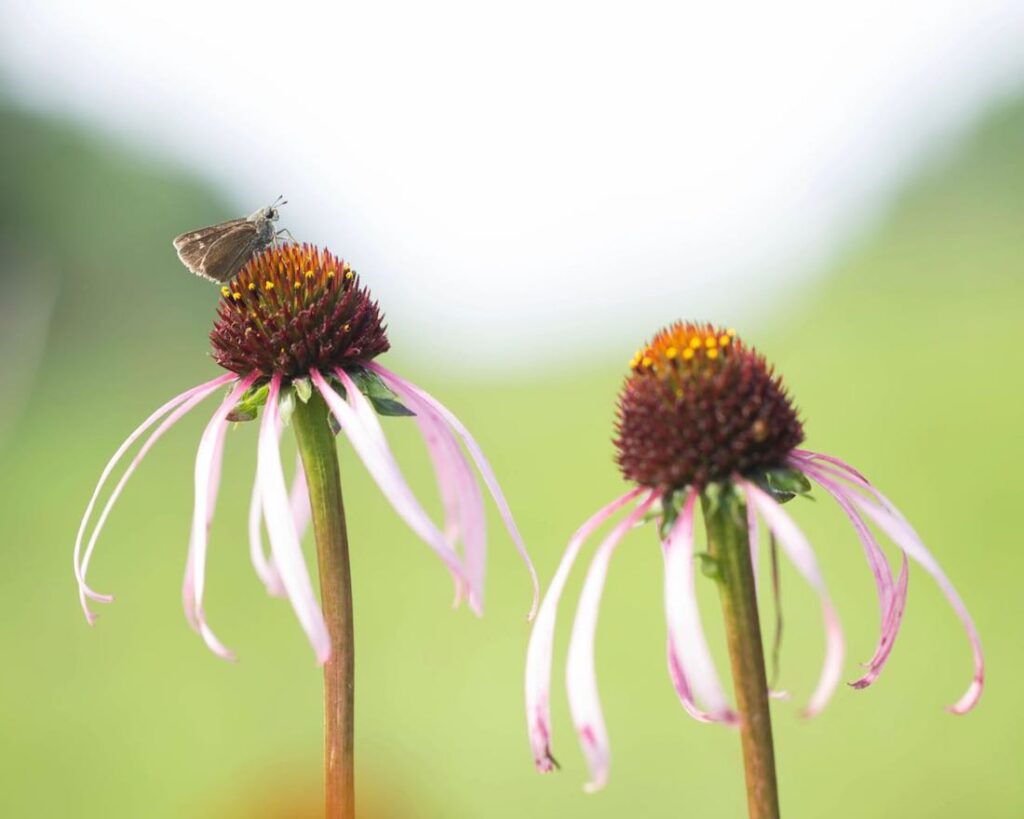
Table of Contents
2024
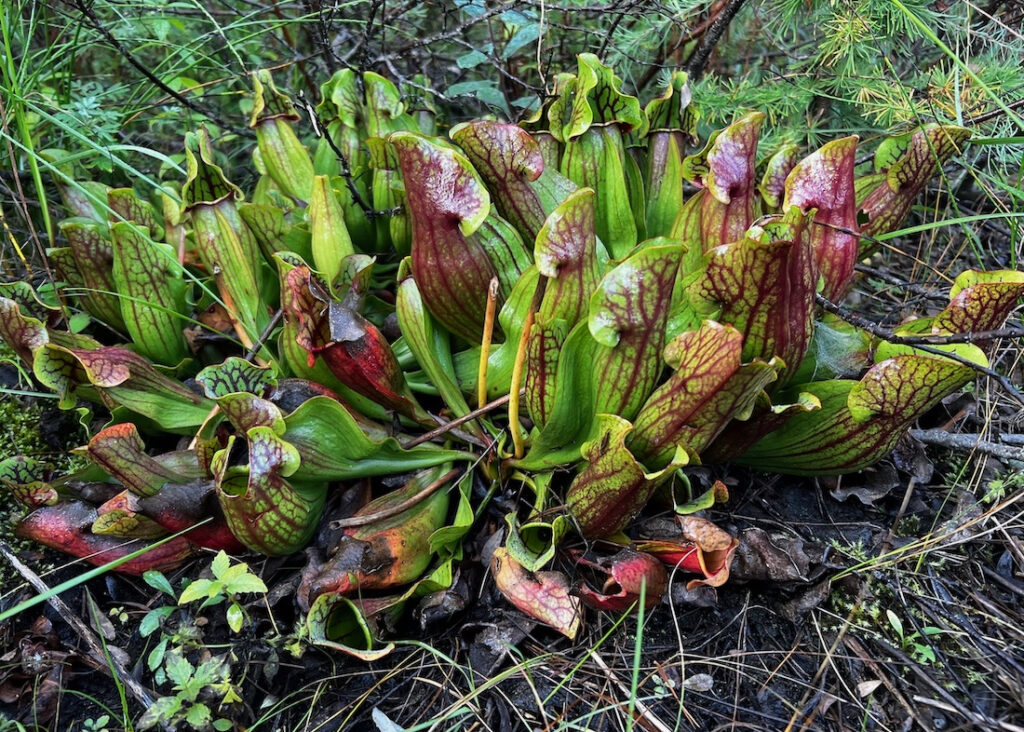
Nicole Burroughs, North Carolina State University
Phytotelmata tell all: Modeling the role of dispersal in community assembly. Advisor: Dr. Will Petry
Phytotelmata tell all: Modeling the role of dispersal in community assembly. Advisor: Dr. Will Petry
Space available in a newly opened pitcher!
When ecologically similar species arrive in the same habitat, what factors influence how communities are formed and persist? Dispersal certainly plays a role. Sarracenia purpurea is an intriguing model to use for understanding the frequency and timing of species dispersal. Their pitchers host a diverse assemblage of microbes that digest drowned prey. Newly opened pitchers are empty but quickly develop rich microbial communities. These microbes must emigrate from other pitchers due to the high degree of specialization among Sarracenia-dwelling species. To investigate how these communities are formed, Nicole intends to construct a field array for monitoring microbial dispersal ability over set distances. She will then combine dispersal results with competition data previously obtained in the lab. This will enable her to perform the first multispecies empirical test of a new ecological theory that predicts possible community assembly pathways.
When ecologically similar species arrive in the same habitat, what factors influence how communities are formed and persist? Dispersal certainly plays a role. Sarracenia purpurea is an intriguing model to use for understanding the frequency and timing of species dispersal. Their pitchers host a diverse assemblage of microbes that digest drowned prey. Newly opened pitchers are empty but quickly develop rich microbial communities. These microbes must emigrate from other pitchers due to the high degree of specialization among Sarracenia-dwelling species. To investigate how these communities are formed, Nicole intends to construct a field array for monitoring microbial dispersal ability over set distances. She will then combine dispersal results with competition data previously obtained in the lab. This will enable her to perform the first multispecies empirical test of a new ecological theory that predicts possible community assembly pathways.
Do Prothonotary Warblers use bryophytes for pest control?
Some birds incorporate fresh, green plants in their nests, but little is known about why they do this. One hypothesis suggests the fresh plants produce compounds that deter arthropods (e.g., insects), including those that may be parasitic (like mites), moderating nest arthropod abundance to promote healthy nest conditions. Most prior investigations have focused on birds that select fresh vascular plants, but little work has been done with birds that use fresh bryophytes, including mosses and liverworts, even though many bryophytes produce arthropod-deterring compounds. Using an established network of five forested wetland field sites in eastern North Carolina, Skadi Kylander will use Prothonotary Warbler (Protonotaria citrea) nests to identify and catalog the plants used in nests and complete chemical analyses of warbler-selected bryophytes to determine whether they produce compounds known to affect arthropods. She will also use information about nest arthropod communities, determined using environmental DNA, to investigate relationships between nest and arthropod community composition. Her project will establish an inventory of plants important to this watchlist bird species in vulnerable wetland habitats and will reveal plant-bird-arthropod associations, information that will contribute to conservation strategies and increase awareness of these inconspicuous plants and relationships.
Skadi Kylander, East Carolina University
Investigating bryophyte use in the nests of the Prothonotary Warbler (Protonotaria citrea). Advisor: Dr. Michael Brewer
Some birds incorporate fresh, green plants in their nests, but little is known about why they do this. One hypothesis suggests the fresh plants produce compounds that deter arthropods (e.g., insects), including those that may be parasitic (like mites), moderating nest arthropod abundance to promote healthy nest conditions. Most prior investigations have focused on birds that select fresh vascular plants, but little work has been done with birds that use fresh bryophytes, including mosses and liverworts, even though many bryophytes produce arthropod-deterring compounds. Using an established network of five forested wetland field sites in eastern North Carolina, Skadi Kylander will use Prothonotary Warbler (Protonotaria citrea) nests to identify and catalog the plants used in nests and complete chemical analyses of warbler-selected bryophytes to determine whether they produce compounds known to affect arthropods. She will also use information about nest arthropod communities, determined using environmental DNA, to investigate relationships between nest and arthropod community composition. Her project will establish an inventory of plants important to this watchlist bird species in vulnerable wetland habitats and will reveal plant-bird-arthropod associations, information that will contribute to conservation strategies and increase awareness of these inconspicuous plants and relationships.
Skadi Kylander, East Carolina University
Investigating bryophyte use in the nests of the Prothonotary Warbler (Protonotaria citrea). Advisor: Dr. Michael Brewer
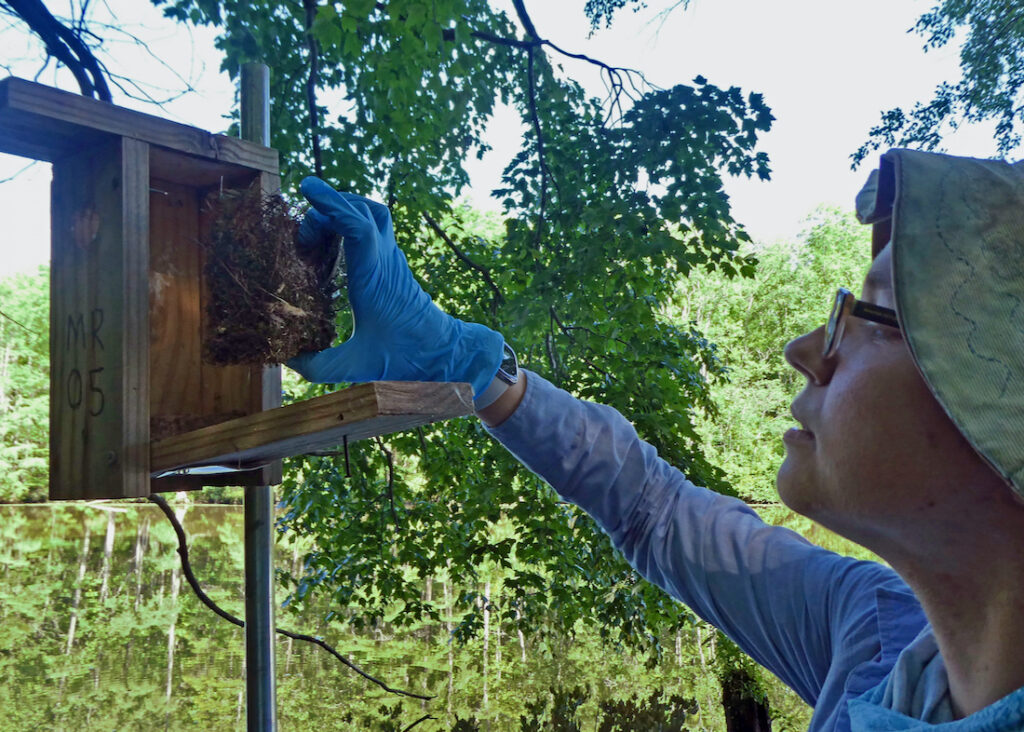
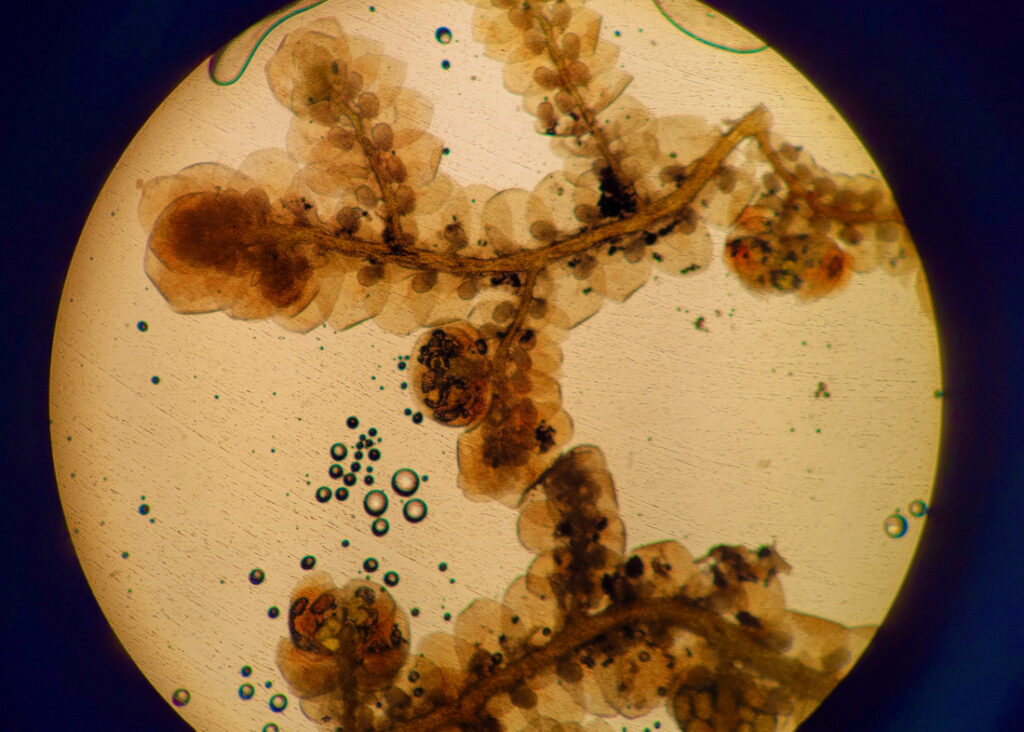
Swamp Pink secrets: Genetic diversity and drift
Helonias bullata (Swamp Pink) is a federally listed wetland plant species that has experienced significant population declines in recent years. Development and urbanization have fractured and extirpated many Helonias occurrences, leading to a mosaic of small, isolated populations throughout its range. Due to the limited number of individuals within many of these populations, Helonias faces the loss of genetic diversity, which can lead to population instability and collapse. Kate’s research focuses on developing an in-depth genetic diversity analysis of the extant Helonias populations in North Carolina using a next-generation sequencing approach. This analysis will allow Kate to identify the occurrence of genetic drift within smaller populations. Results from this research can be used in future management decisions such as genetic rescue implementation and habitat conservation.
Helonias bullata (Swamp Pink) is a federally listed wetland plant species that has experienced significant population declines in recent years. Development and urbanization have fractured and extirpated many Helonias occurrences, leading to a mosaic of small, isolated populations throughout its range. Due to the limited number of individuals within many of these populations, Helonias faces the loss of genetic diversity, which can lead to population instability and collapse. Kate’s research focuses on developing an in-depth genetic diversity analysis of the extant Helonias populations in North Carolina using a next-generation sequencing approach. This analysis will allow Kate to identify the occurrence of genetic drift within smaller populations. Results from this research can be used in future management decisions such as genetic rescue implementation and habitat conservation.
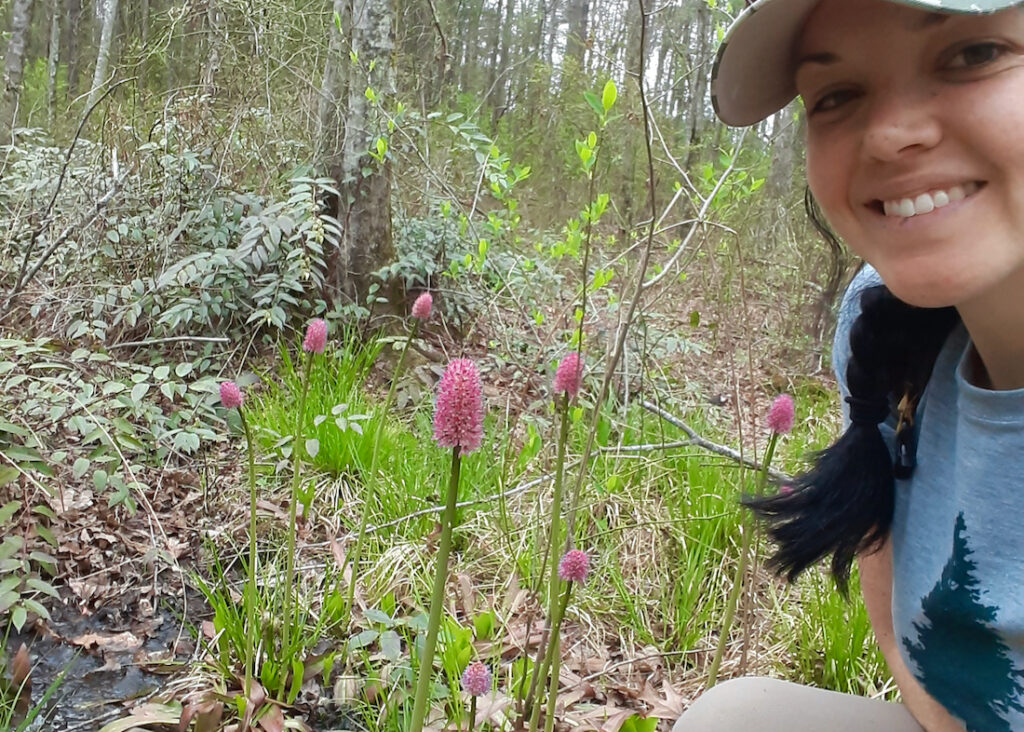
Kate Loughran, Appalachian State University
Secrets of the Swamp: Uncovering the genetic diversity of a federally threatened wetland species, swamp pink (Helonias bullata). Advisor: Dr. Matt Estep
Secrets of the Swamp: Uncovering the genetic diversity of a federally threatened wetland species, swamp pink (Helonias bullata). Advisor: Dr. Matt Estep
2023
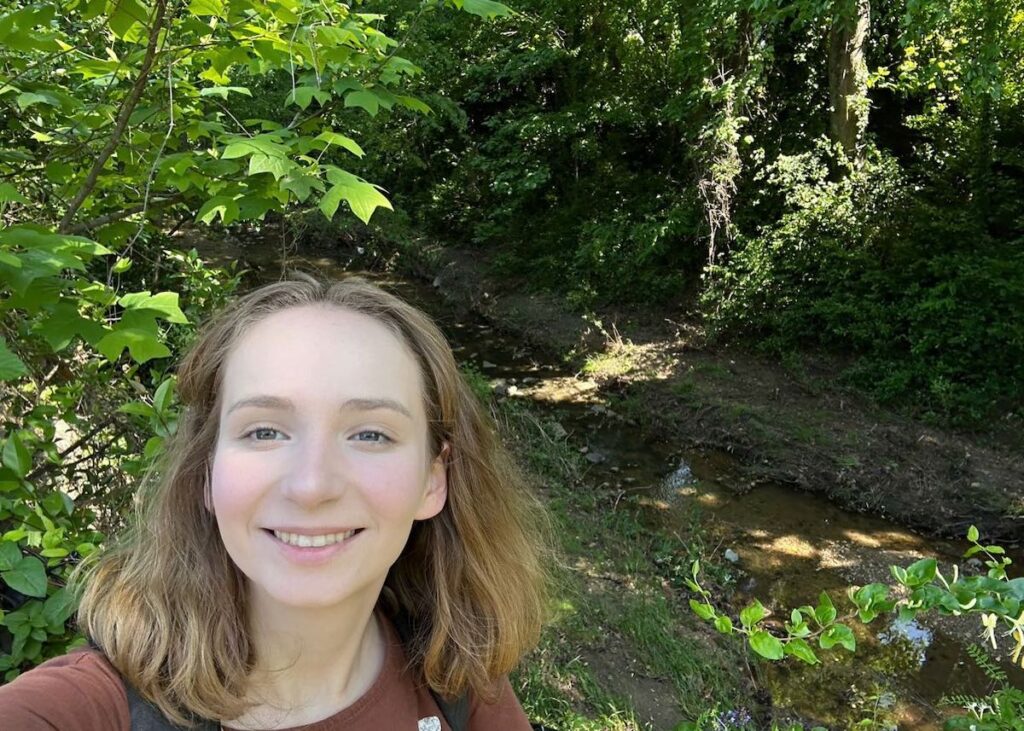
Lauren Willhite, North Carolina State University
Long-term survivorship and species invasion post-restoration on Rocky Branch. Advisor: Dr. Steph Jeffries
read full report
Master’s thesis
Long-term survivorship and species invasion post-restoration on Rocky Branch. Advisor: Dr. Steph Jeffries
read full report
Master’s thesis
Do Invasive Species Win the Long Game in Urban Stream Restoration?
Urban stream restoration is used to preserve water quality, native species abundance, and habitat connectivity in the landscape. Restoration of Rocky Branch, a perennial stream in Raleigh, was a pioneering stream restoration effort and occurred in three phases 21, 17, and 13 years ago. The site provided a unique opportunity for Lauren Willhite to examine plant communities post-restoration and to determine what native species, both planted and volunteer, perform best. Invasive species are also present at Rocky Branch, and Lauren investigated which invasive species took over sites along the stream and the resulting ecological impacts on the plant communities (i.e. diversity, dominance, survival). She addressed these questions by collecting data within 10-meter transects along the stream, noting whether the species was planted, a volunteer, or invasive, in addition to assessing the survival of all planted species and the structure of plant communities. This work informs future investment decisions and planting lists for other stream restoration projects in the southeastern US by examining the success of frequently planted natives.
Urban stream restoration is used to preserve water quality, native species abundance, and habitat connectivity in the landscape. Restoration of Rocky Branch, a perennial stream in Raleigh, was a pioneering stream restoration effort and occurred in three phases 21, 17, and 13 years ago. The site provided a unique opportunity for Lauren Willhite to examine plant communities post-restoration and to determine what native species, both planted and volunteer, perform best. Invasive species are also present at Rocky Branch, and Lauren investigated which invasive species took over sites along the stream and the resulting ecological impacts on the plant communities (i.e. diversity, dominance, survival). She addressed these questions by collecting data within 10-meter transects along the stream, noting whether the species was planted, a volunteer, or invasive, in addition to assessing the survival of all planted species and the structure of plant communities. This work informs future investment decisions and planting lists for other stream restoration projects in the southeastern US by examining the success of frequently planted natives.
Using Herbarium Specimens to Evaluate Climate Change Impacts
One of the primary threats to at-risk carnivorous plant species is climate change. The specialized ecologies of carnivorous plants make them particularly sensitive to environmental changes, often making them the first species to disappear in their ecosystems. Notable responses to climate change are phenological shifts in flowering due to increased temperatures and the frequency and intensity of droughts. Not only are these factors known to directly affect plant reproduction but may also have indirect impacts via symbiotic relationships between plants and pollinators. Duke undergraduate Lydia Cox plans to use the Southeast Regional Network of Expertise and Collections (SERNEC) herbarium database to collect data on flowering phenology – both flowering characteristics and timing – of Venus fly traps (Dionaea muscipula) and seven pitcher plant (Sarracenia) species that are native to North Carolina. With specimens dating back to the early 1800s, these historical flowering data will be linked to climate databases to assess possible relationships between climate change and their phenology. Her research will tap into the underutilized resource of herbarium collections and elucidate the potential effects of climate change on the flowering phenology of these charismatic carnivorous plants of North Carolina.
One of the primary threats to at-risk carnivorous plant species is climate change. The specialized ecologies of carnivorous plants make them particularly sensitive to environmental changes, often making them the first species to disappear in their ecosystems. Notable responses to climate change are phenological shifts in flowering due to increased temperatures and the frequency and intensity of droughts. Not only are these factors known to directly affect plant reproduction but may also have indirect impacts via symbiotic relationships between plants and pollinators. Duke undergraduate Lydia Cox plans to use the Southeast Regional Network of Expertise and Collections (SERNEC) herbarium database to collect data on flowering phenology – both flowering characteristics and timing – of Venus fly traps (Dionaea muscipula) and seven pitcher plant (Sarracenia) species that are native to North Carolina. With specimens dating back to the early 1800s, these historical flowering data will be linked to climate databases to assess possible relationships between climate change and their phenology. Her research will tap into the underutilized resource of herbarium collections and elucidate the potential effects of climate change on the flowering phenology of these charismatic carnivorous plants of North Carolina.
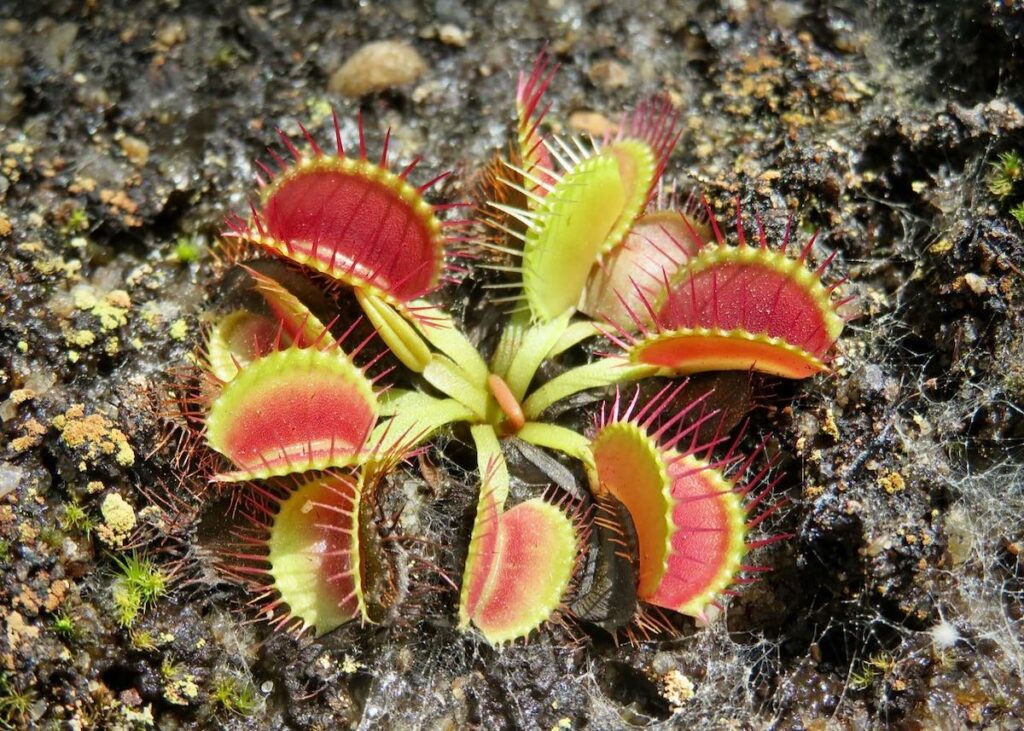
Lydia Cox, Duke University
Herbarium collections assist with disentangling the effects of climate change on flowering phenology of native carnivorous plants. Advisors: Dr. Natalie Z. Kerr and Dr. William Morris
Herbarium collections assist with disentangling the effects of climate change on flowering phenology of native carnivorous plants. Advisors: Dr. Natalie Z. Kerr and Dr. William Morris
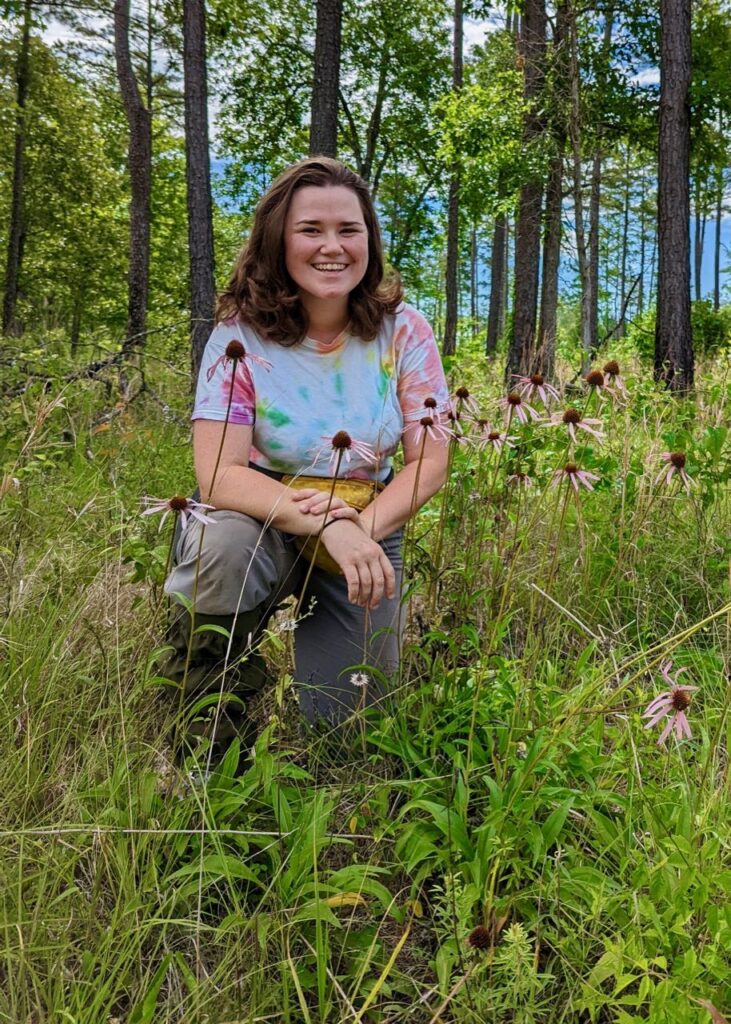
Thriving is better than surviving for Echinacea laevigata
The Smooth purple coneflower (Echinacea laevigata (Boynton & Beadle) Blake) is a rare southeastern perennial associated with the imperiled “Piedmont prairie” grassland system. Though research and recovery efforts have bolstered and protected enough populations for the US Fish & Wildlife Service to downlist the species from Endangered to Threatened in 2022, several key pieces of information about the reproduction of the coneflower are still needed to inform continuing conservation efforts. This summer, Erin Eichenberger will continue a multi-year demographic survey in collaboration with the NC Botanic Garden and NC Plant Conservation Program to determine whether ongoing management efforts are promoting population growth, and how canopy closure and shading out of these light-loving plants affect survival and recruitment. She will also sample floral visitors across the range of the coneflower (from Virginia to Georgia) to understand variation in the community of insect pollinators, critical to the reproduction of the species. This research will help ensure that populations of the Smooth Purple Coneflower are managed not just for survival but also for growth and expansion, critical for the recovery of the species.
Erin Eichenberger, North Carolina State University
Investigating populations and pollinators of Echinacea laevigata (Asteraceae) to further conservation efforts. Advisor: Dr. Rebecca Irwin
The Smooth purple coneflower (Echinacea laevigata (Boynton & Beadle) Blake) is a rare southeastern perennial associated with the imperiled “Piedmont prairie” grassland system. Though research and recovery efforts have bolstered and protected enough populations for the US Fish & Wildlife Service to downlist the species from Endangered to Threatened in 2022, several key pieces of information about the reproduction of the coneflower are still needed to inform continuing conservation efforts. This summer, Erin Eichenberger will continue a multi-year demographic survey in collaboration with the NC Botanic Garden and NC Plant Conservation Program to determine whether ongoing management efforts are promoting population growth, and how canopy closure and shading out of these light-loving plants affect survival and recruitment. She will also sample floral visitors across the range of the coneflower (from Virginia to Georgia) to understand variation in the community of insect pollinators, critical to the reproduction of the species. This research will help ensure that populations of the Smooth Purple Coneflower are managed not just for survival but also for growth and expansion, critical for the recovery of the species.
Erin Eichenberger, North Carolina State University
Investigating populations and pollinators of Echinacea laevigata (Asteraceae) to further conservation efforts. Advisor: Dr. Rebecca Irwin
Natural variation in the longleaf pine savanna
The longleaf pine savanna ecosystem, once extensive throughout the southeastern United States, has been reduced to 3% of its original range. Restoration efforts are ongoing throughout its former range from small landowner initiatives to larger, cooperative efforts. These efforts would benefit from further research into how longleaf pine (Pinus palustris) seedlings and various understory species respond to environmental pressures. Jordan Winter plans to investigate how plants from different populations across the range, which have evolved to local conditions, respond when subjected to the same growing conditions and stresses. He will conduct a multi-year growth experiment using ecotypes of longleaf pine, Beyrich Threeawn (Aristida beyrichiana), and various legumes (Fabaceae spp.) to explore the impacts of drought and nutrient addition. This research will highlight the impact different ecotypes can have on the potential health and function of the longleaf pine savanna restorations.
Jordan Winter, University of North Carolina at Greensboro
The effect of ecotype on longleaf pine savanna understory plant resilience using three key understory species: longleaf pine (Pinus palustris) seedling, Beyrich Threeawn (Aristida beyrichiana), and legume (Fabaceae spp.). Advisor: Dr. Sally Koerner
The longleaf pine savanna ecosystem, once extensive throughout the southeastern United States, has been reduced to 3% of its original range. Restoration efforts are ongoing throughout its former range from small landowner initiatives to larger, cooperative efforts. These efforts would benefit from further research into how longleaf pine (Pinus palustris) seedlings and various understory species respond to environmental pressures. Jordan Winter plans to investigate how plants from different populations across the range, which have evolved to local conditions, respond when subjected to the same growing conditions and stresses. He will conduct a multi-year growth experiment using ecotypes of longleaf pine, Beyrich Threeawn (Aristida beyrichiana), and various legumes (Fabaceae spp.) to explore the impacts of drought and nutrient addition. This research will highlight the impact different ecotypes can have on the potential health and function of the longleaf pine savanna restorations.
Jordan Winter, University of North Carolina at Greensboro
The effect of ecotype on longleaf pine savanna understory plant resilience using three key understory species: longleaf pine (Pinus palustris) seedling, Beyrich Threeawn (Aristida beyrichiana), and legume (Fabaceae spp.). Advisor: Dr. Sally Koerner
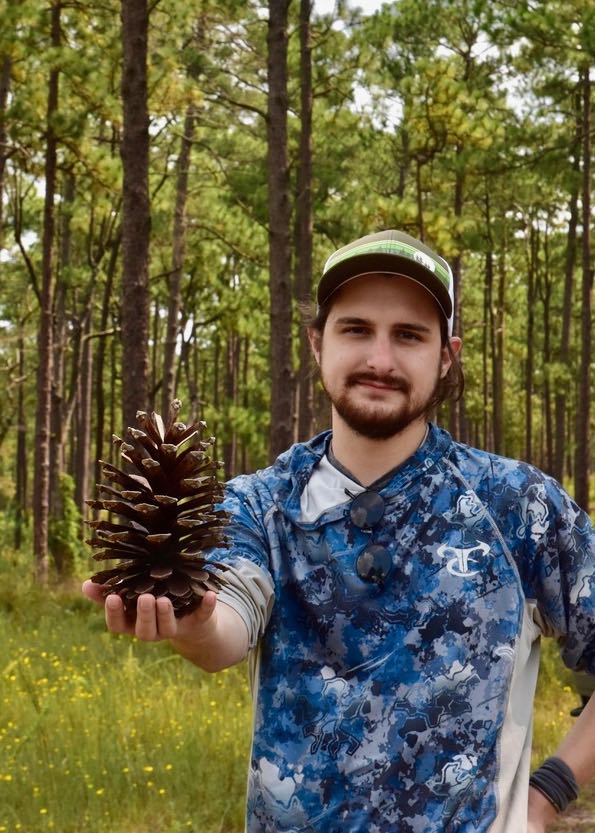
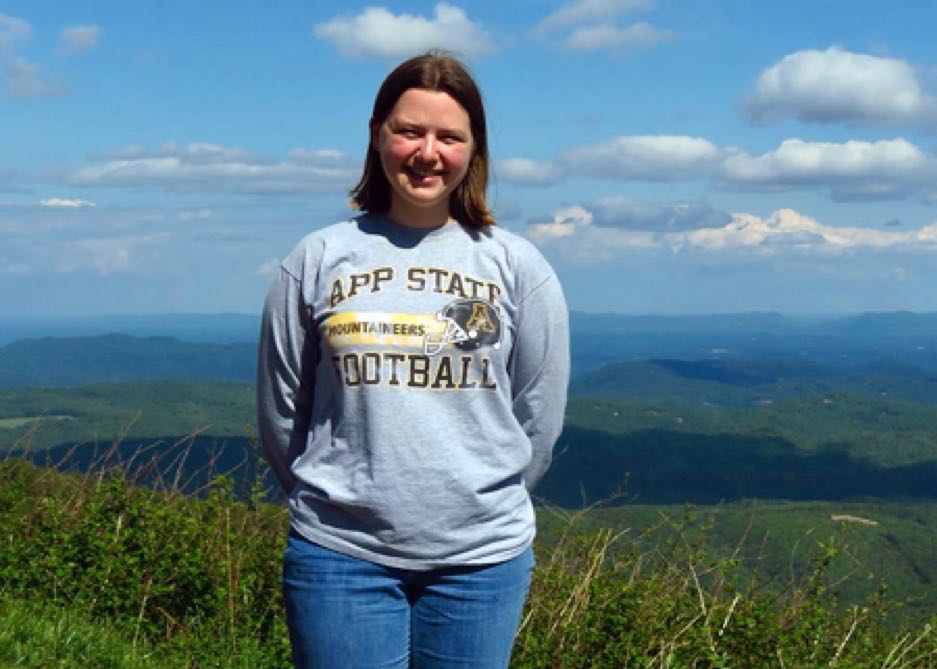
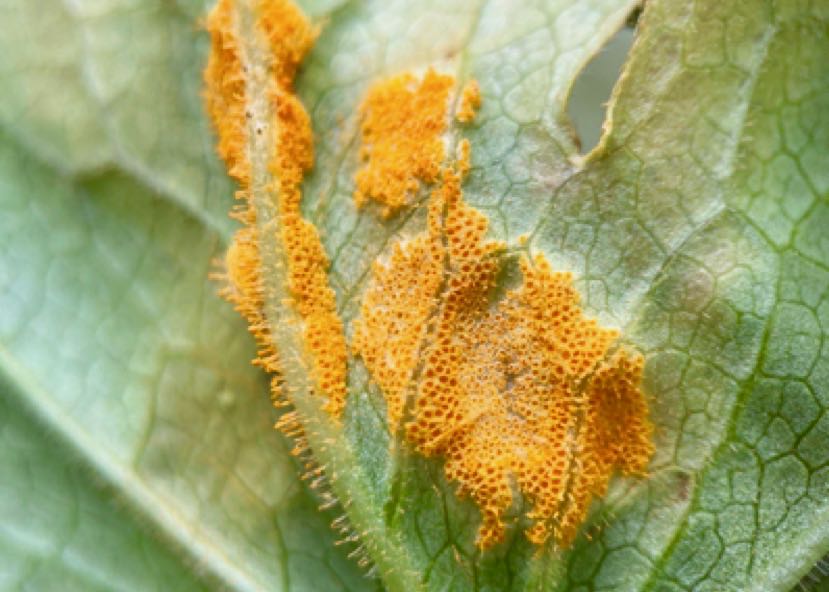
Uncovering fungi lurking in native plants in the Great Smokies
Endophytes are a type of microbial fungi that live within plants. Worldwide there are hundreds of thousands of these organisms, but only a fraction have been cataloged. Many can’t be seen with the naked eye, but some manifest physically as leaf spots. These blemishes can be large brightly colored growths or subtle brown freckles on leaves. The effects on a plant’s health range from beneficial to benign to pathogenic. With so little known about the role of endophytes in natural plant communities, foundational survey work is the essential first step. Working with the US Department of Interior, Annika Fockler’s research will focus on identifying endophyte leaf spots found in high frequencies in the Great Smoky Mountains National Park and along the Blue Ridge Parkway. Annika will use the large online iNaturalist community and the images posted by users to locate plants of interest that exhibit signs of infection. After collecting samples and processing them in the lab, DNA sequencing will be used to identify the endophytes. This research will help understand which fungi are destructive to their hosts and which could be useful in improving the health of Southern Appalachian plant communities.
Annika Fockler, Appalachian State University
Leaf spot endophytes in Southern Appalachian woodland plants. Advisor: Dr. Annkatrin Rose
Endophytes are a type of microbial fungi that live within plants. Worldwide there are hundreds of thousands of these organisms, but only a fraction have been cataloged. Many can’t be seen with the naked eye, but some manifest physically as leaf spots. These blemishes can be large brightly colored growths or subtle brown freckles on leaves. The effects on a plant’s health range from beneficial to benign to pathogenic. With so little known about the role of endophytes in natural plant communities, foundational survey work is the essential first step. Working with the US Department of Interior, Annika Fockler’s research will focus on identifying endophyte leaf spots found in high frequencies in the Great Smoky Mountains National Park and along the Blue Ridge Parkway. Annika will use the large online iNaturalist community and the images posted by users to locate plants of interest that exhibit signs of infection. After collecting samples and processing them in the lab, DNA sequencing will be used to identify the endophytes. This research will help understand which fungi are destructive to their hosts and which could be useful in improving the health of Southern Appalachian plant communities.
Annika Fockler, Appalachian State University
Leaf spot endophytes in Southern Appalachian woodland plants. Advisor: Dr. Annkatrin Rose
Who is eating what when
Herbivory is an important driver of grassland and savanna dynamics, influencing nutrient cycling and trophic energy transfer. Arthropod herbivores account for the majority of herbivory in grassland systems. Therefore, understanding arthropod herbivory and the role it plays in structuring ecosystems is critical, especially as the current ‘insect apocalypse’ unfolds, a worldwide, annual 1-2% decrease in insect abundance due to global change factors. The relationship between arthropod herbivory and the environment is especially important in the longleaf pine (LLP) savanna system, where arthropods are the primary herbivores. Will Mann will investigate how two global change factors– drought and nutrient deposition– interact to influence herbivore damage over multiple years and within a season. This work will help illuminate an underdeveloped part of LLP savanna research.
Will Mann, University of North Carolina at Greensboro
Nutrient deposition and drought effects on arthropod herbivore damage in longleaf pine savanna understory. Advisor: Dr. Sally Koerner
Herbivory is an important driver of grassland and savanna dynamics, influencing nutrient cycling and trophic energy transfer. Arthropod herbivores account for the majority of herbivory in grassland systems. Therefore, understanding arthropod herbivory and the role it plays in structuring ecosystems is critical, especially as the current ‘insect apocalypse’ unfolds, a worldwide, annual 1-2% decrease in insect abundance due to global change factors. The relationship between arthropod herbivory and the environment is especially important in the longleaf pine (LLP) savanna system, where arthropods are the primary herbivores. Will Mann will investigate how two global change factors– drought and nutrient deposition– interact to influence herbivore damage over multiple years and within a season. This work will help illuminate an underdeveloped part of LLP savanna research.
Will Mann, University of North Carolina at Greensboro
Nutrient deposition and drought effects on arthropod herbivore damage in longleaf pine savanna understory. Advisor: Dr. Sally Koerner
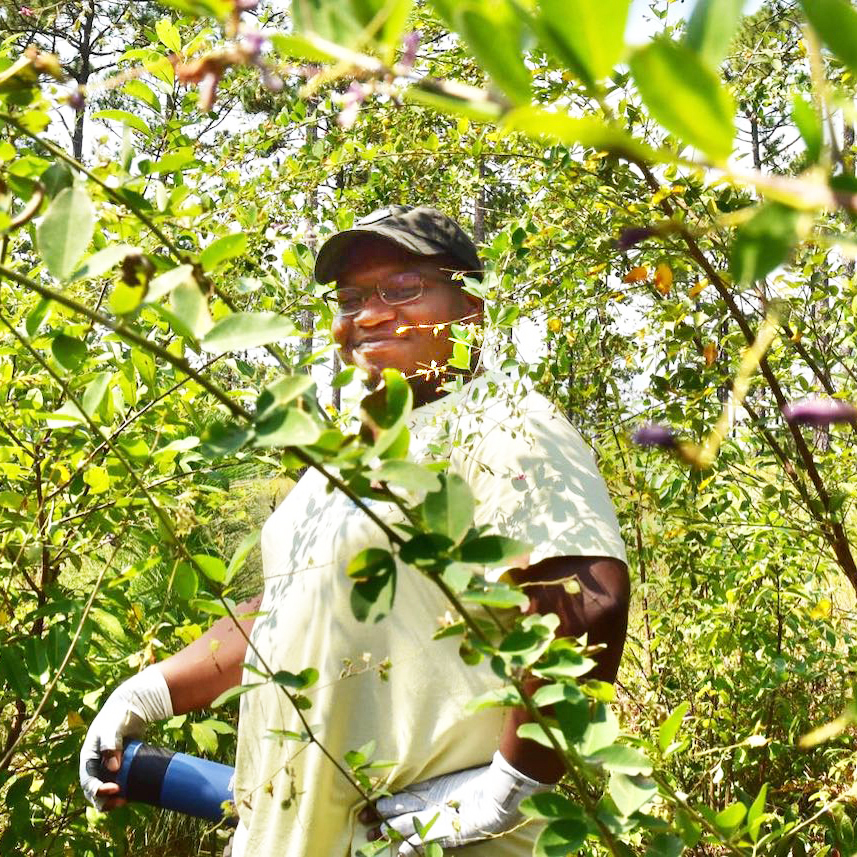
2022
The Role of Microbial Communities in Pitcher Plants
The Purple Pitcher Plant, Sarracenia purpurea, uses its brightly colored pitchers to attract insect prey to its water-filled tubes, where they fall in and drown. Nutrients and minerals from the digested prey are absorbed through the walls of the pitcher plant tube, which functions somewhat like a stomach. However, S. purpurea does not have the ability to digest its captured prey, as the plant lacks the necessary enzymes. Instead, it relies on a diversity of organisms to perform this task. Microbes play an essential role in this process, and therefore significantly influence the plant’s overall health, but the significance of microbial diversity within the pitchers is poorly understood. Katrina DeWitt plans to study how environmental factors, such as temperature along an altitudinal gradient, change S. purpurea microbial communities and, in turn, affect growth and morphology of the pitchers. Her research will show how this dynamic can be perturbed by alterations of temperature and nutrient availability, and how profound these effects can be on the fitness of the pitcher plants.
Katrina DeWitt, Duke University
Microbial diversity in the native pitcher plant Sarracenia purpurea: the role of environmental factors across short temporal scales. Advisor: Dr. Jean Philippe Gibert
The Purple Pitcher Plant, Sarracenia purpurea, uses its brightly colored pitchers to attract insect prey to its water-filled tubes, where they fall in and drown. Nutrients and minerals from the digested prey are absorbed through the walls of the pitcher plant tube, which functions somewhat like a stomach. However, S. purpurea does not have the ability to digest its captured prey, as the plant lacks the necessary enzymes. Instead, it relies on a diversity of organisms to perform this task. Microbes play an essential role in this process, and therefore significantly influence the plant’s overall health, but the significance of microbial diversity within the pitchers is poorly understood. Katrina DeWitt plans to study how environmental factors, such as temperature along an altitudinal gradient, change S. purpurea microbial communities and, in turn, affect growth and morphology of the pitchers. Her research will show how this dynamic can be perturbed by alterations of temperature and nutrient availability, and how profound these effects can be on the fitness of the pitcher plants.
Katrina DeWitt, Duke University
Microbial diversity in the native pitcher plant Sarracenia purpurea: the role of environmental factors across short temporal scales. Advisor: Dr. Jean Philippe Gibert
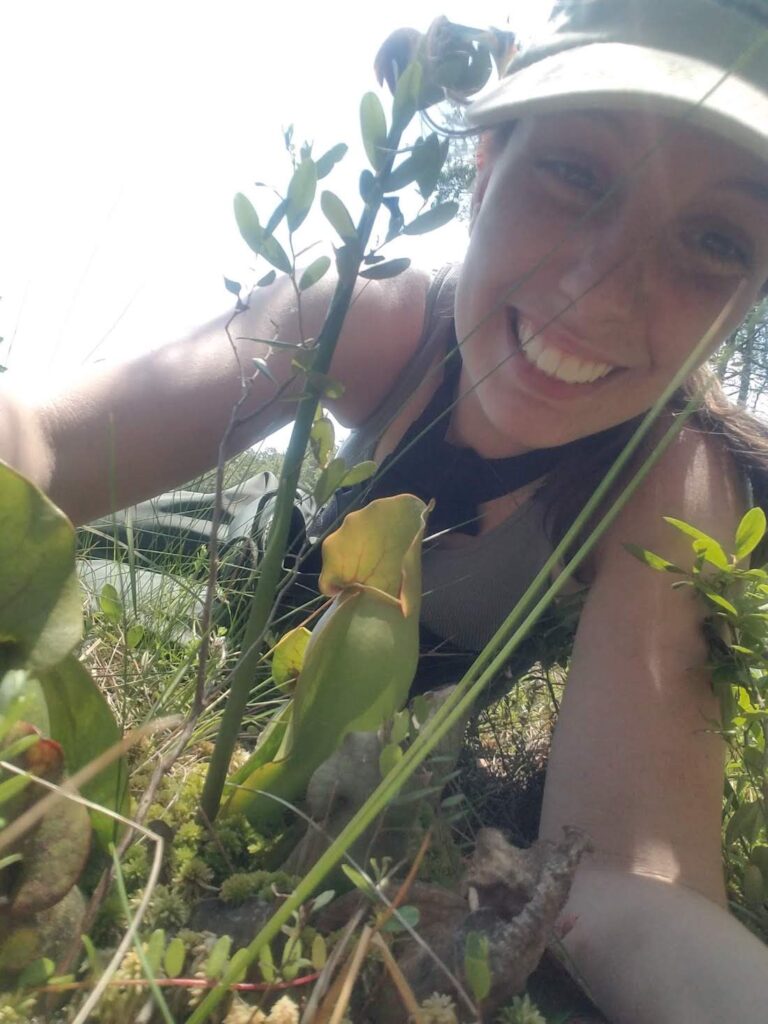
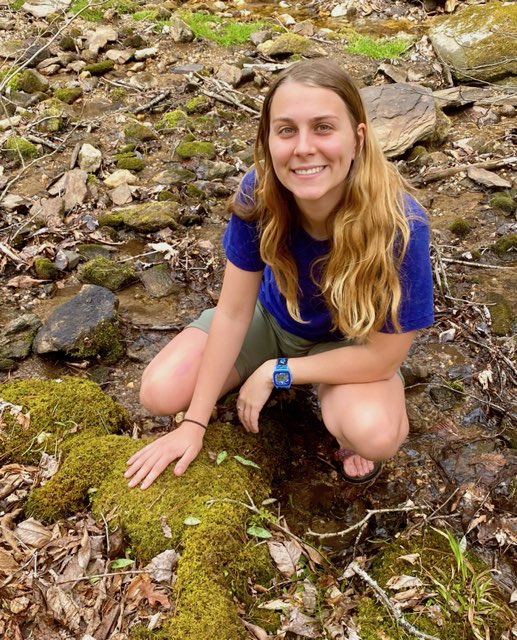
Mosses Respond to Changing Climatic Conditions
In the Southern Appalachian Mountains mosses are highly abundant, and at least 368 species have been recorded in the area. In the mountains, as elsewhere, bryophytes are thought of as bioindicators of forest integrity. However, moss communities are sensitive to variable precipitation patterns and higher temperatures and could be severely impacted by changing climatic conditions. To understand these impacts, Leigha Henson utilized an outdoor experimental system to subject six Southern Appalachian moss species, grown in large tubs, to various climate regimes. She recorded responses of the mosses for a year, measuring growth, chlorophyll and moisture content, photosynthesis response curves, CO2 gas exchange, and chlorophyll fluorescence, which gives indication of robustness of the photosynthetic pathway. Leigha’s research provides insight on an understudied but vital component of the Southern Appalachian Mountains.
Leigha Henson, Appalachian State University
Warming and precipitation effects on several common moss species of the Southern Appalachian Mountains. Advisor: Dr. Howard Neufeld
read full report
In the Southern Appalachian Mountains mosses are highly abundant, and at least 368 species have been recorded in the area. In the mountains, as elsewhere, bryophytes are thought of as bioindicators of forest integrity. However, moss communities are sensitive to variable precipitation patterns and higher temperatures and could be severely impacted by changing climatic conditions. To understand these impacts, Leigha Henson utilized an outdoor experimental system to subject six Southern Appalachian moss species, grown in large tubs, to various climate regimes. She recorded responses of the mosses for a year, measuring growth, chlorophyll and moisture content, photosynthesis response curves, CO2 gas exchange, and chlorophyll fluorescence, which gives indication of robustness of the photosynthetic pathway. Leigha’s research provides insight on an understudied but vital component of the Southern Appalachian Mountains.
Leigha Henson, Appalachian State University
Warming and precipitation effects on several common moss species of the Southern Appalachian Mountains. Advisor: Dr. Howard Neufeld
read full report
Taking a Close Look at the Variable Early Saxifrage
Early Saxifrage (Micranthes virginiensis) is a small, herbaceous flowering plant with a broad distribution from Arkansas to Maine and variable morphology, which could mask cryptic species. Newly discovered populations from the escarpment region of North Carolina and South Carolina have atypical floral characteristics and inconclusive relationships to other Micranthes species. Additionally, varying numbers of chromosomes have been reported in several populations. Tara Hall will investigate the taxonomy and cytology of Early Saxifrage, collecting from multiple populations to perform meiotic chromosome counts, compare morphological characteristics, and sequence the DNA to reconstruct the phylogenetic relationships. Her results will identify potential cryptic species or hybrid populations within this widespread taxon that could be of conservation concern.
Tara Hall, Western Carolina University
A Study of morphological, cytological, and molecular variation in the eastern North American flowering plant, Micranthes virginiensis (Saxifragaceae). Advisor: Dr. Kathy Mathews
Early Saxifrage (Micranthes virginiensis) is a small, herbaceous flowering plant with a broad distribution from Arkansas to Maine and variable morphology, which could mask cryptic species. Newly discovered populations from the escarpment region of North Carolina and South Carolina have atypical floral characteristics and inconclusive relationships to other Micranthes species. Additionally, varying numbers of chromosomes have been reported in several populations. Tara Hall will investigate the taxonomy and cytology of Early Saxifrage, collecting from multiple populations to perform meiotic chromosome counts, compare morphological characteristics, and sequence the DNA to reconstruct the phylogenetic relationships. Her results will identify potential cryptic species or hybrid populations within this widespread taxon that could be of conservation concern.
Tara Hall, Western Carolina University
A Study of morphological, cytological, and molecular variation in the eastern North American flowering plant, Micranthes virginiensis (Saxifragaceae). Advisor: Dr. Kathy Mathews
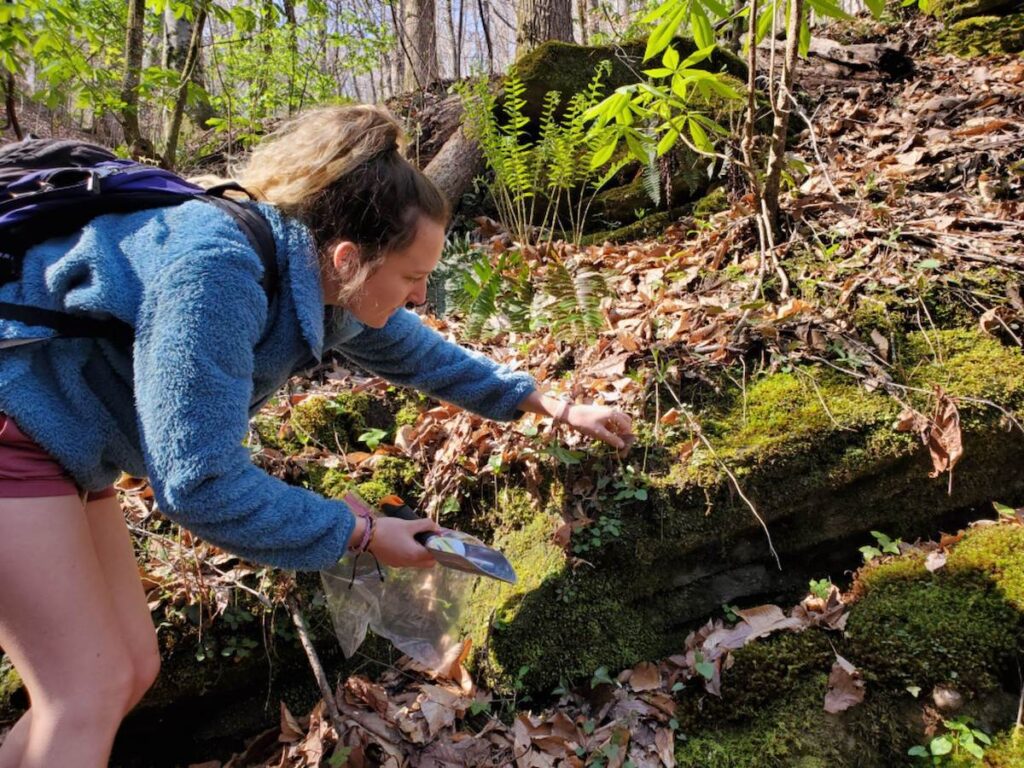
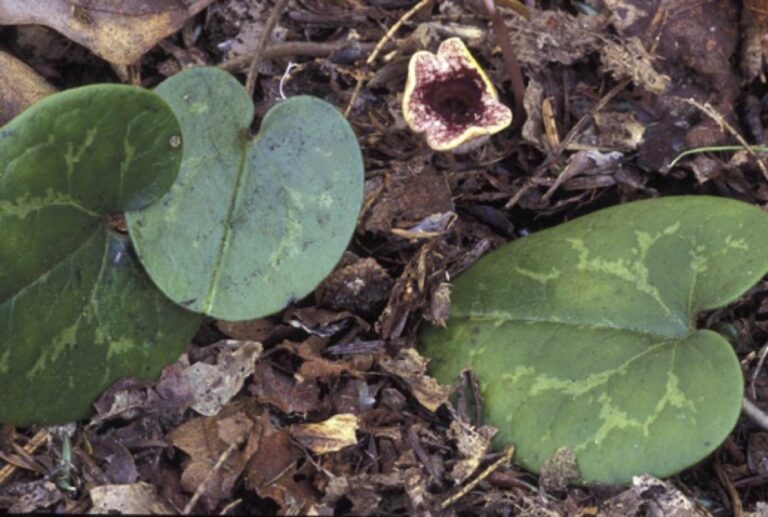
Monitoring the Mountain Heartleaf
Ecosystem management decisions and actions often center on keystone species or species with high economic value. However, failing to monitor vulnerable non-focal species under potential management scenarios could unintentionally put them at even greater risk of extinction. For this reason, as the United States Forest Service (USFS) conducts a pilot experiment comparing different timber management treatments, they will partner with Ryan O’Connell to assess the effects of these management interventions on a non-focal species of conservation concern: the Mountain Heartleaf (Hexastylis contracta). With the help of USFS staff, Ryan will conduct demographic surveys to be used for modeling population trajectories of the Mountain Heartleaf under each management scenario. The ultimate goal of this effort is to ensure that future large-scale timber management actions are chosen to minimize potentially adverse effects on rare species such as Mountain Heartleaf.
Ryan O’Connell, Duke university
Evaluating the impact of timber management strategies on mountain heartleaf (Hexastylis contracta), a species of conservation concern. Advisor: Dr. William Morris
Ecosystem management decisions and actions often center on keystone species or species with high economic value. However, failing to monitor vulnerable non-focal species under potential management scenarios could unintentionally put them at even greater risk of extinction. For this reason, as the United States Forest Service (USFS) conducts a pilot experiment comparing different timber management treatments, they will partner with Ryan O’Connell to assess the effects of these management interventions on a non-focal species of conservation concern: the Mountain Heartleaf (Hexastylis contracta). With the help of USFS staff, Ryan will conduct demographic surveys to be used for modeling population trajectories of the Mountain Heartleaf under each management scenario. The ultimate goal of this effort is to ensure that future large-scale timber management actions are chosen to minimize potentially adverse effects on rare species such as Mountain Heartleaf.
Ryan O’Connell, Duke university
Evaluating the impact of timber management strategies on mountain heartleaf (Hexastylis contracta), a species of conservation concern. Advisor: Dr. William Morris
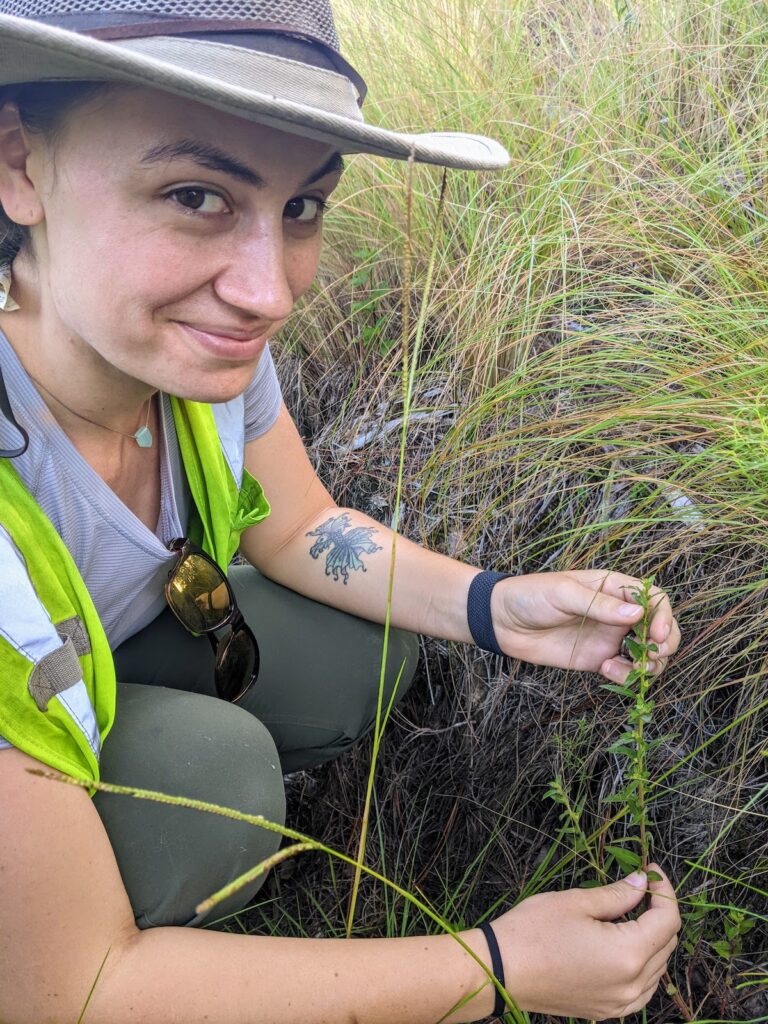
Living in a Ditch is not Ideal
Raven’s Seedbox (Ludwigia ravenii) is a critically imperiled wetland plant under review for federal listing. Although historically known from natural habitats, Raven’s Seedbox currently exists in a precarious state, as it is known only from artificial and unprotected habitats. These include roadside ditches and vehicle ruts in wet depressions, leaving populations vulnerable to disturbance. Despite this, no research has been conducted on the specific habitat requirements of Raven’s Seedbox, which represents a foundational knowledge gap for species conservation efforts. Merry Conlin filled that gap by quantitatively characterizing the biotic and abiotic factors of habitats where the species is currently found. This valuable life history data is essential in listing decisions and management of the species.
Merry Conlin, North Carolina State University
The inconspicuous Ludwigia: Quantitative habitat characterization of critically imperiled Ludwigia ravenii (Onagraceae). Advisor: Dr. Alexander Krings
read full report
Raven’s Seedbox (Ludwigia ravenii) is a critically imperiled wetland plant under review for federal listing. Although historically known from natural habitats, Raven’s Seedbox currently exists in a precarious state, as it is known only from artificial and unprotected habitats. These include roadside ditches and vehicle ruts in wet depressions, leaving populations vulnerable to disturbance. Despite this, no research has been conducted on the specific habitat requirements of Raven’s Seedbox, which represents a foundational knowledge gap for species conservation efforts. Merry Conlin filled that gap by quantitatively characterizing the biotic and abiotic factors of habitats where the species is currently found. This valuable life history data is essential in listing decisions and management of the species.
Merry Conlin, North Carolina State University
The inconspicuous Ludwigia: Quantitative habitat characterization of critically imperiled Ludwigia ravenii (Onagraceae). Advisor: Dr. Alexander Krings
read full report
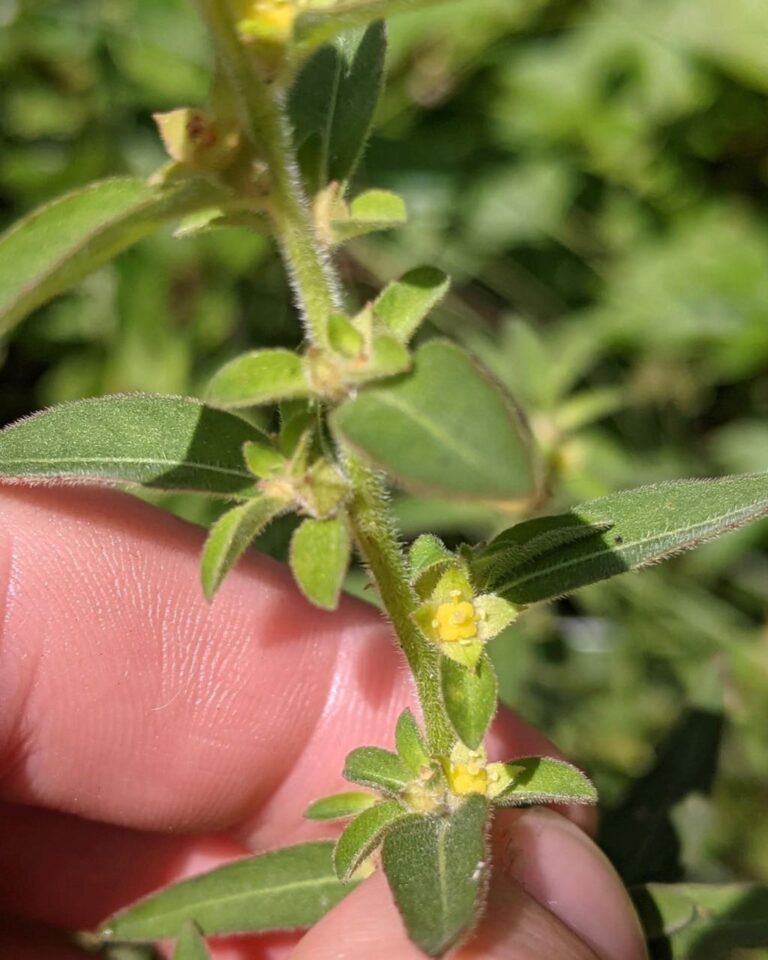
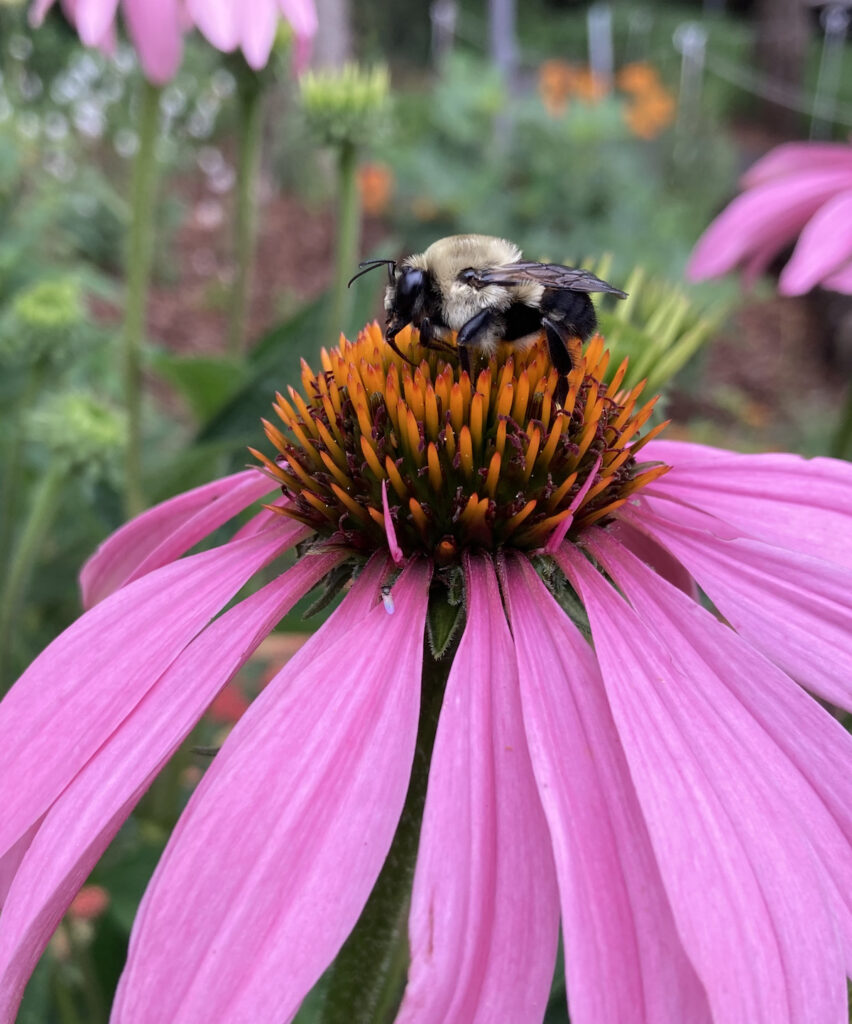
Climate-Induced Bee Declines and Plant Fitness
Researchers have measured the upper limit for heat tolerance in wild bee species, known as the critical thermal maximum, above which bees lose muscular control and cannot fly. Heat-sensitive bees could become unable to visit flowering plants if future climate conditions lead to increased air temperatures. This threatens to perturb the plant-pollinator network in unforeseen ways. Melina Keighron experimentally tested the outcome of pollinator loss on a community of plant species at NCSU’s Agroecology Farm. She used pollinator flight cages to sequentially limit the number of bee species available to pollinate five native plants, reducing the bee species by order of those most sensitive to high temperatures. By recording pollination visits and collecting and quantifying pollen grains from bees and plants, Melina empirically examined how the loss of pollinator species and subsequent network rewiring affects the reproduction of the five native plant species.
Melina Keighron, North Carolina State University
The Effects of climate change-induced wild bee pollinator declines on plant fitness. Advisor: Dr. Elsa Youngstead
read full report
Researchers have measured the upper limit for heat tolerance in wild bee species, known as the critical thermal maximum, above which bees lose muscular control and cannot fly. Heat-sensitive bees could become unable to visit flowering plants if future climate conditions lead to increased air temperatures. This threatens to perturb the plant-pollinator network in unforeseen ways. Melina Keighron experimentally tested the outcome of pollinator loss on a community of plant species at NCSU’s Agroecology Farm. She used pollinator flight cages to sequentially limit the number of bee species available to pollinate five native plants, reducing the bee species by order of those most sensitive to high temperatures. By recording pollination visits and collecting and quantifying pollen grains from bees and plants, Melina empirically examined how the loss of pollinator species and subsequent network rewiring affects the reproduction of the five native plant species.
Melina Keighron, North Carolina State University
The Effects of climate change-induced wild bee pollinator declines on plant fitness. Advisor: Dr. Elsa Youngstead
read full report
Plant Community Changes in Coastal Ghost Forests
Images of ghost forests are striking visuals on how saltwater intrusion from sea-level rise is impacting North Carolina’s coastal wetlands. These forested freshwater wetlands sequester large amounts of carbon and provide habitat for many rare and endangered understory plants, yet they are highly vulnerable to saltwater intrusion. Salt exposure is leading to widespread tree mortality and plant community composition change, which negatively impacts carbon storage. Aeran Coughlin investigated shifts in these plant communities and how the transitions relate to biogeochemical changes and plant-soil microbial feedbacks. Aeran used several one kilometer transects across salt exposure gradients to collect soil samples and characterize woody and herbaceous plant communities.
Aeran Coughlin, Duke University
Saltwater-induced community change in forested coastal wetlands of North Carolina. Advisor: Justin Wright
read full report
Images of ghost forests are striking visuals on how saltwater intrusion from sea-level rise is impacting North Carolina’s coastal wetlands. These forested freshwater wetlands sequester large amounts of carbon and provide habitat for many rare and endangered understory plants, yet they are highly vulnerable to saltwater intrusion. Salt exposure is leading to widespread tree mortality and plant community composition change, which negatively impacts carbon storage. Aeran Coughlin investigated shifts in these plant communities and how the transitions relate to biogeochemical changes and plant-soil microbial feedbacks. Aeran used several one kilometer transects across salt exposure gradients to collect soil samples and characterize woody and herbaceous plant communities.
Aeran Coughlin, Duke University
Saltwater-induced community change in forested coastal wetlands of North Carolina. Advisor: Justin Wright
read full report
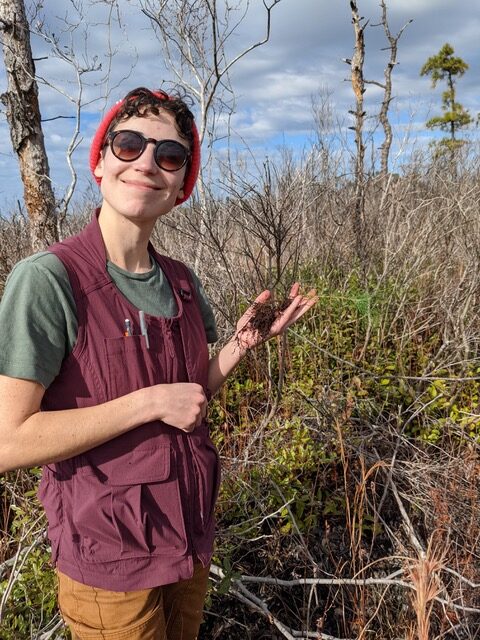
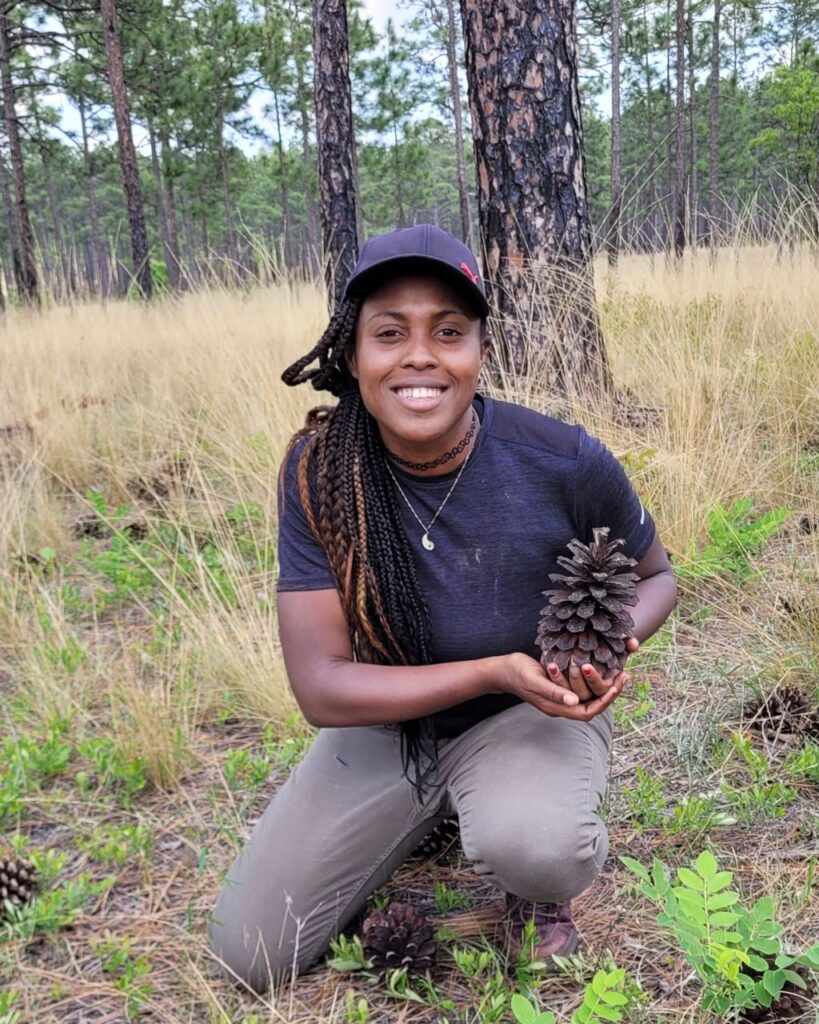
Effects of Drought on Longleaf Pine Savanna
The longleaf pine savanna once covered 60 to 90 million acres across southeastern US, but has dwindled to about 3% of its original range. The remaining habitat faces many threats, including the uncertain impact from global climate change. Fire is an essential component in maintaining the savanna ecosystem, allowing a diverse understory plant community to flourish. However, increasing droughts due to changing climate conditions could hinder regeneration of plants after fires and result in negative cascading effects throughout the forest ecosystem. To investigate these effects, Rachel Vinson collected plant and insect composition data from simulated drought and control study plots located in the Sandhills Game Lands. This was the fourth year of data collection at the site, and she used this large data set to show how the plant community responded over time to decreased rainfall.
Rachel Vinson, University of North Carolina at Greensboro
The effects of drought on plant and insect species composition in the longleaf pines (Pinus palustris) savanna. Advisor: Dr. Sally Koerner
read full report
The longleaf pine savanna once covered 60 to 90 million acres across southeastern US, but has dwindled to about 3% of its original range. The remaining habitat faces many threats, including the uncertain impact from global climate change. Fire is an essential component in maintaining the savanna ecosystem, allowing a diverse understory plant community to flourish. However, increasing droughts due to changing climate conditions could hinder regeneration of plants after fires and result in negative cascading effects throughout the forest ecosystem. To investigate these effects, Rachel Vinson collected plant and insect composition data from simulated drought and control study plots located in the Sandhills Game Lands. This was the fourth year of data collection at the site, and she used this large data set to show how the plant community responded over time to decreased rainfall.
Rachel Vinson, University of North Carolina at Greensboro
The effects of drought on plant and insect species composition in the longleaf pines (Pinus palustris) savanna. Advisor: Dr. Sally Koerner
read full report
Locust Pocus
Robinia is a small North American genus of black locust trees. Two species found in North Carolina, Robinia hartwigii and Robinia viscosa, are critically imperiled. R. hartwigii is endemic solely to granite outcrops near Highlands, NC. Brandon Wheeler’s research focused on understanding their evolutionary relationships as well as their taxonomic validity. DNA sequence data from this project highlights effective conservation strategies by identifying possible deleterious effects of small population sizes and interbreeding that could imperil both species in the future. Brandon also spent time leading hikes to see these plants in order to promote their conservation in their native range, which is rapidly being developed.
Brandon Wheeler, Western Carolina University
Locust Pocus: Morphological and molecular tests of species delimitation in Robinia of the southeastern United States. Advisor: Dr. Kathy Mathews
link to thesis
Robinia is a small North American genus of black locust trees. Two species found in North Carolina, Robinia hartwigii and Robinia viscosa, are critically imperiled. R. hartwigii is endemic solely to granite outcrops near Highlands, NC. Brandon Wheeler’s research focused on understanding their evolutionary relationships as well as their taxonomic validity. DNA sequence data from this project highlights effective conservation strategies by identifying possible deleterious effects of small population sizes and interbreeding that could imperil both species in the future. Brandon also spent time leading hikes to see these plants in order to promote their conservation in their native range, which is rapidly being developed.
Brandon Wheeler, Western Carolina University
Locust Pocus: Morphological and molecular tests of species delimitation in Robinia of the southeastern United States. Advisor: Dr. Kathy Mathews
link to thesis
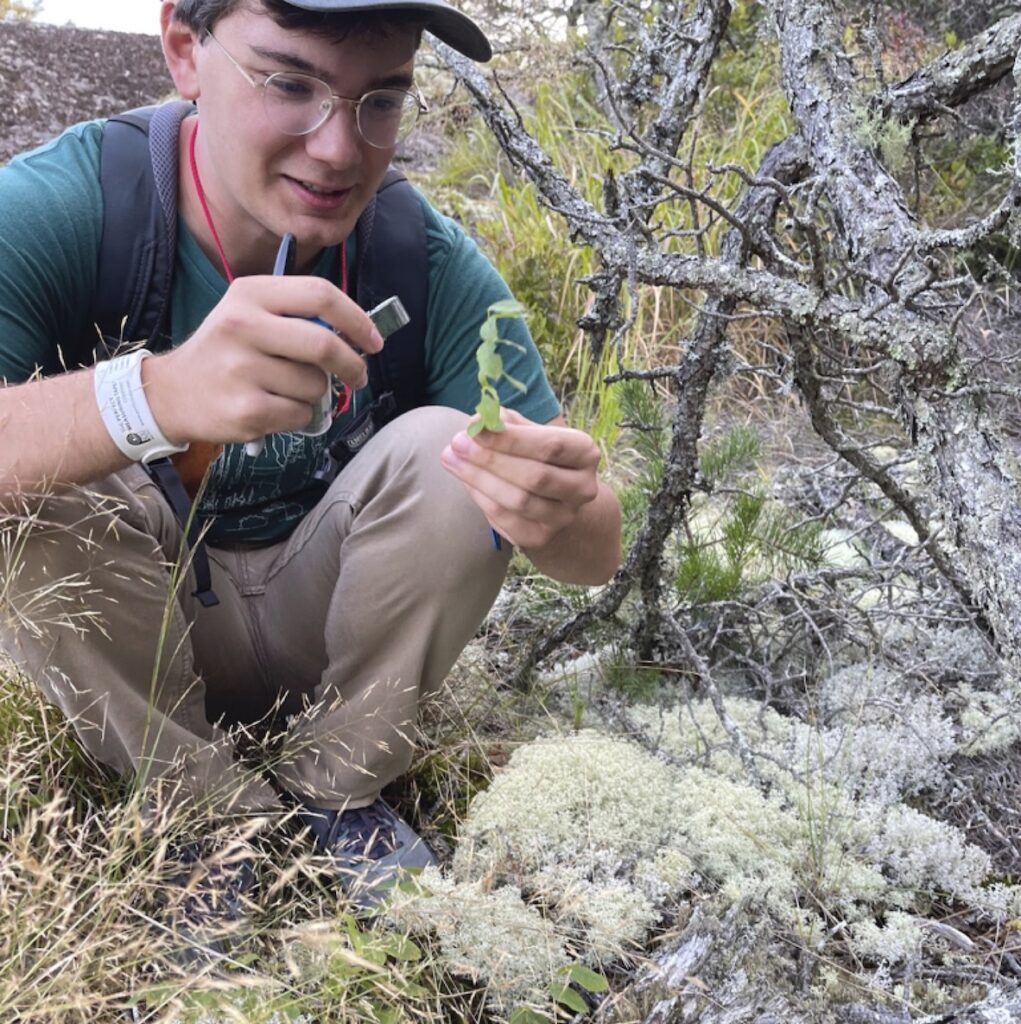
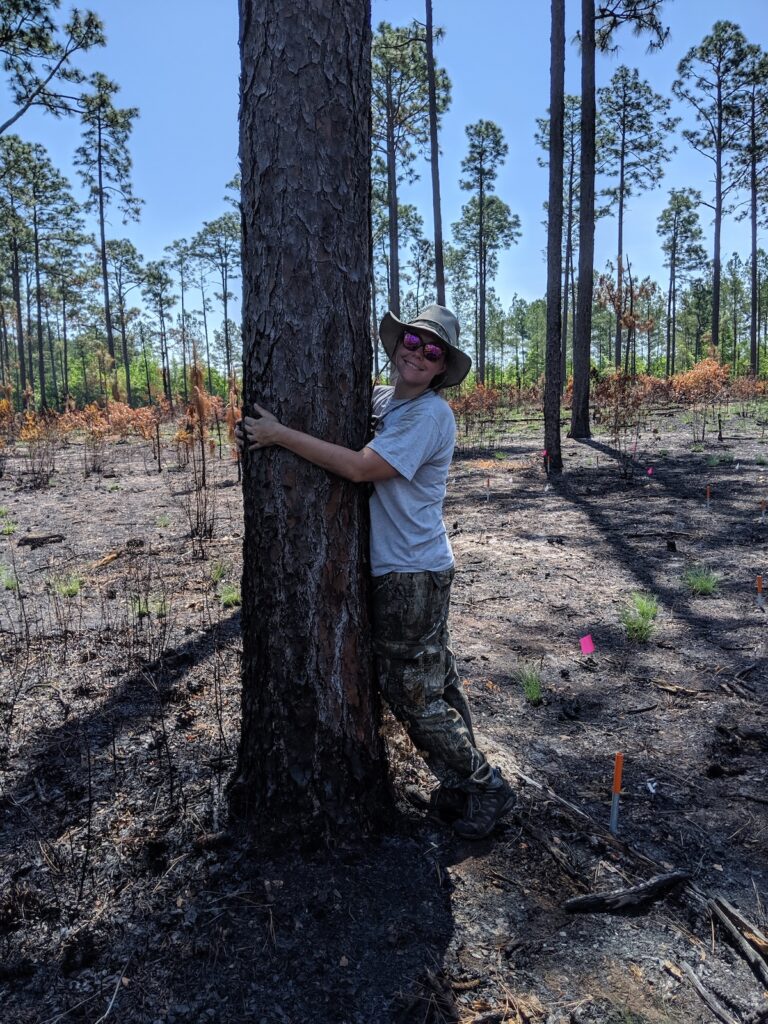
Rhizobia Inocculations using Native Legumes
Legumes are common in the longleaf pine savanna understory, where they form a symbiotic relationship with bacteria called rhizobia. Rhizobia fix atmospheric nitrogen into forms that legumes can utilize, recycling this essential nutrient to the ecosystem. Alyssa Young researches the potential for rhizobia inoculations to positively influence the understory restorations through increased availability of nitrogen. To investigate this, Alyssa will measure the nitrogen-fixing ability of five native legume species, identify the rhizobia species each plant harbors, and inoculate plants with rhizobia found to fix the most nitrogen. She will then see if these inoculations lead to higher soil and leaf tissue nitrogen content of the native legumes.
Alyssa Young, University of North Carolina at Greensboro
Legume-rhizobia specificity and inoculation as a potential tool in restoration. Advisor: Dr. Sally Koerner
Legumes are common in the longleaf pine savanna understory, where they form a symbiotic relationship with bacteria called rhizobia. Rhizobia fix atmospheric nitrogen into forms that legumes can utilize, recycling this essential nutrient to the ecosystem. Alyssa Young researches the potential for rhizobia inoculations to positively influence the understory restorations through increased availability of nitrogen. To investigate this, Alyssa will measure the nitrogen-fixing ability of five native legume species, identify the rhizobia species each plant harbors, and inoculate plants with rhizobia found to fix the most nitrogen. She will then see if these inoculations lead to higher soil and leaf tissue nitrogen content of the native legumes.
Alyssa Young, University of North Carolina at Greensboro
Legume-rhizobia specificity and inoculation as a potential tool in restoration. Advisor: Dr. Sally Koerner
2021
Roadside verges as habitat for Piedmont savanna wildflowers
Rural roadside verges harbor diverse communities of Piedmont savanna wildflowers, many of which depend on insect pollinators. Can this roadside habitat support the persistence of Piedmont savanna wildflower populations in modern anthropogenic landscapes? Adair McNear researched insect pollinators and the effect of road age among rural roadside populations of three wildflower species: Wild Quinine (Parthenium integrifolium), Narrowleaf Mountain Mint (Pycnanthemum tenuifolium), and Purple False Foxglove (Agalinis purpurea). Adair tested insect-driven pollen transfer using UV dyes in experimental populations of A. purpurea that mimic the spatial arrangement of roadside A. purpurea populations. Adair’s goal were to understand the mechanisms that allow Piedmont savanna wildflowers to persist in roadside habitats and to inform management and conservation of roadside savanna plant populations in the near and long term.
Adair McNear, University of North Carolina at Chapel Hill
Characterizing the functional ecology of Piedmont savanna wildflowers in roadside verges by road infrastructure age and testing pollen transfer. Advisor: Dr. Johnny Randall
read full report
Rural roadside verges harbor diverse communities of Piedmont savanna wildflowers, many of which depend on insect pollinators. Can this roadside habitat support the persistence of Piedmont savanna wildflower populations in modern anthropogenic landscapes? Adair McNear researched insect pollinators and the effect of road age among rural roadside populations of three wildflower species: Wild Quinine (Parthenium integrifolium), Narrowleaf Mountain Mint (Pycnanthemum tenuifolium), and Purple False Foxglove (Agalinis purpurea). Adair tested insect-driven pollen transfer using UV dyes in experimental populations of A. purpurea that mimic the spatial arrangement of roadside A. purpurea populations. Adair’s goal were to understand the mechanisms that allow Piedmont savanna wildflowers to persist in roadside habitats and to inform management and conservation of roadside savanna plant populations in the near and long term.
Adair McNear, University of North Carolina at Chapel Hill
Characterizing the functional ecology of Piedmont savanna wildflowers in roadside verges by road infrastructure age and testing pollen transfer. Advisor: Dr. Johnny Randall
read full report
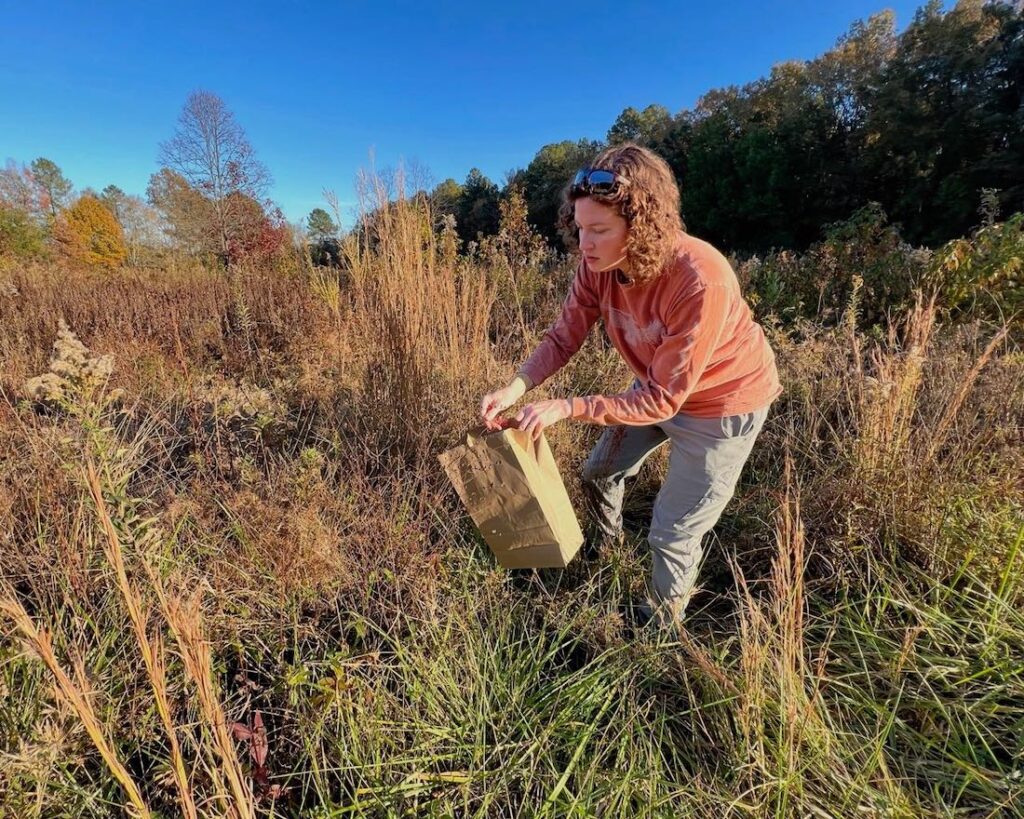
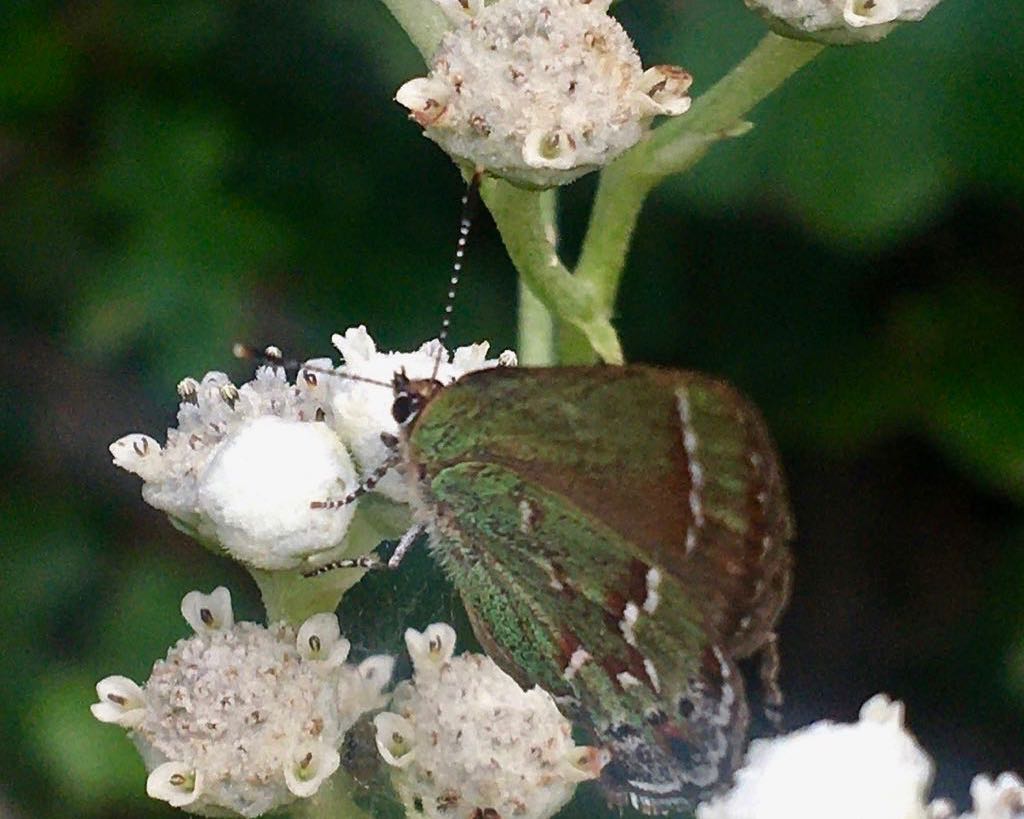
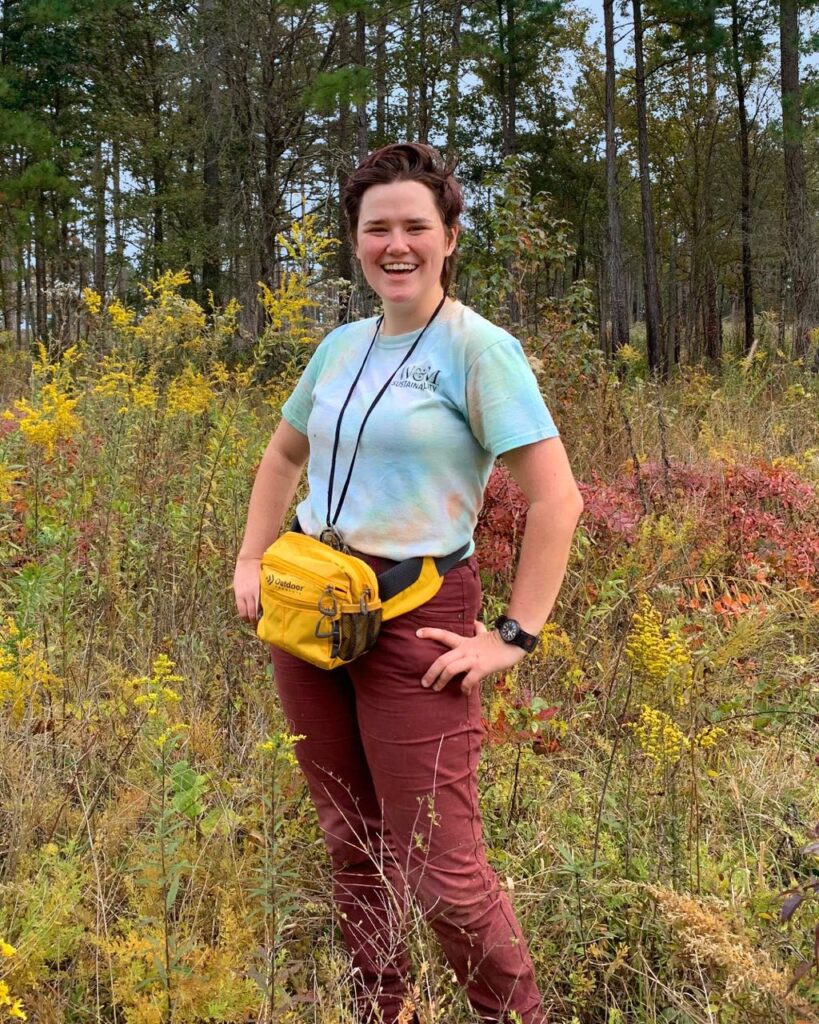
Establishing Native Prairie Plants
Impressive Piedmont prairies were once common in the landscape, maintained by Native American burning practices. Sadly, these are now reduced to remnants, but restoration efforts work to re-establish and maintain this plant community. Germination and establishment of prairie seedlings are crucial to the success of these projects, but they are frequently understudied. Erin Eichenberger focused her research on filling this data gap by investigating how different restoration treatments and soil types influence the establishment of seedlings. Using eight native prairie species, she performed field and greenhouse experiments to explore seedling germination and growth in response to burning, tree thinning and soil/light/moisture conditions. These findings guide restoration efforts for a vanishing plant community.
Erin Eichenberger, North Carolina State University Determining germination and establishment requirements of native prairie plants. Advisor: Dr. Rebecca Irwin
read full report
Impressive Piedmont prairies were once common in the landscape, maintained by Native American burning practices. Sadly, these are now reduced to remnants, but restoration efforts work to re-establish and maintain this plant community. Germination and establishment of prairie seedlings are crucial to the success of these projects, but they are frequently understudied. Erin Eichenberger focused her research on filling this data gap by investigating how different restoration treatments and soil types influence the establishment of seedlings. Using eight native prairie species, she performed field and greenhouse experiments to explore seedling germination and growth in response to burning, tree thinning and soil/light/moisture conditions. These findings guide restoration efforts for a vanishing plant community.
Erin Eichenberger, North Carolina State University Determining germination and establishment requirements of native prairie plants. Advisor: Dr. Rebecca Irwin
read full report
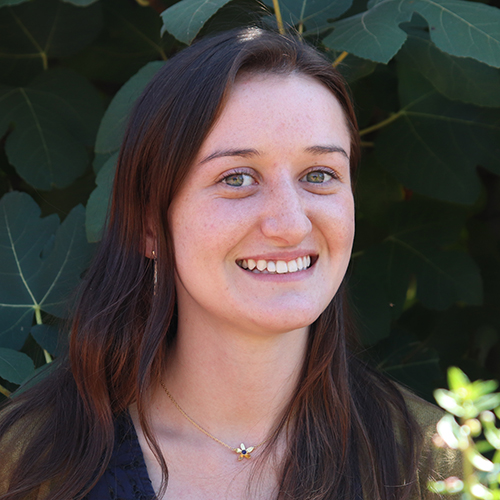
Genetic Roadmap for Houstonia montana
Houstonia montana (Rubiaceae) is a federally listed, endangered herbaceous perennial endemic to the high-elevation rock outcrops and grassy balds of North Carolina, Tennessee, and Virginia. The high light availability and shallow soils of these environments provide a unique habitat for rare plants like H. montana, but this microrefugium is threatened by climate change. One component of Kira Lindelof’s dissertation work was to research the environmental range limits of this vulnerable species. In addition, she used genotyping-by-sequencing to produce a “genetic roadmap” for H. montana, which provides detailed information about the population genetics of the species for guiding downstream conservation work.
Kira Lindelof, North Carolina State University
Applied conservation genetics: GBS and building a genetic roadmap for the recovery of Houstonia montana, an imperiled high-elevation, southern Appalachian endemic. Advisor: Dr. Alexander Krings
read full report
Houstonia montana (Rubiaceae) is a federally listed, endangered herbaceous perennial endemic to the high-elevation rock outcrops and grassy balds of North Carolina, Tennessee, and Virginia. The high light availability and shallow soils of these environments provide a unique habitat for rare plants like H. montana, but this microrefugium is threatened by climate change. One component of Kira Lindelof’s dissertation work was to research the environmental range limits of this vulnerable species. In addition, she used genotyping-by-sequencing to produce a “genetic roadmap” for H. montana, which provides detailed information about the population genetics of the species for guiding downstream conservation work.
Kira Lindelof, North Carolina State University
Applied conservation genetics: GBS and building a genetic roadmap for the recovery of Houstonia montana, an imperiled high-elevation, southern Appalachian endemic. Advisor: Dr. Alexander Krings
read full report
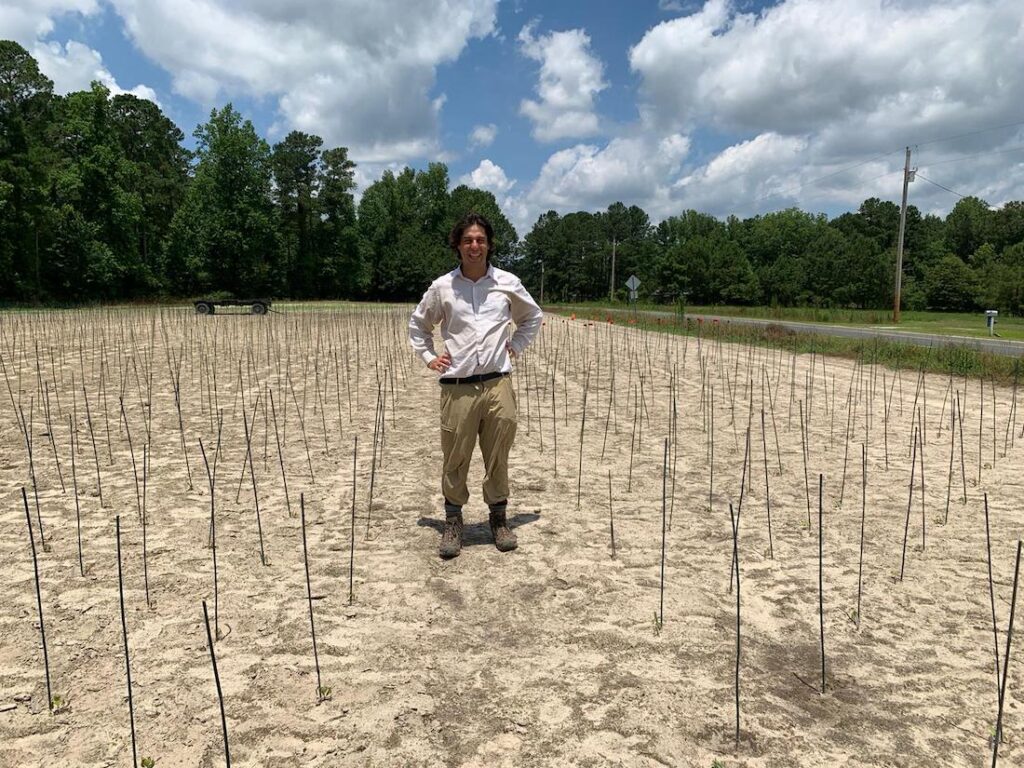
Morning Glory Story: Can Flower Color Save Species
In North Carolina, one costly threat of climate change is that common species will invade ranges of rare endemics, interbreed, contribute more genetic material to the hybrid offspring, and drive the rare species to extinction. Alternatively, rare species can be maintained despite hybridization if selection on traits that impede successful outcrossing and fertile seeds (barrier traits) is greater than the rate of gene flow. To understand how selection may help maintain species boundaries, Jonathan Colen will use two native morning glories: tievine (Ipomoea cordatotriloba) and whitestar morning glory (Ipomoea lacunosa). Through a manipulative field experiment, Jonathan will test whether a potential barrier trait – pink flower color – increases fitness through selection. His research on how species boundaries are maintained despite asymmetric gene flow will ideally be applied to understand the fates of many endangered species.
Jonathan Colen, Duke University
Assessing how selection maintains species boundaries in the face of asymmetric gene flow. Advisor: Dr. Mark Rausher
In North Carolina, one costly threat of climate change is that common species will invade ranges of rare endemics, interbreed, contribute more genetic material to the hybrid offspring, and drive the rare species to extinction. Alternatively, rare species can be maintained despite hybridization if selection on traits that impede successful outcrossing and fertile seeds (barrier traits) is greater than the rate of gene flow. To understand how selection may help maintain species boundaries, Jonathan Colen will use two native morning glories: tievine (Ipomoea cordatotriloba) and whitestar morning glory (Ipomoea lacunosa). Through a manipulative field experiment, Jonathan will test whether a potential barrier trait – pink flower color – increases fitness through selection. His research on how species boundaries are maintained despite asymmetric gene flow will ideally be applied to understand the fates of many endangered species.
Jonathan Colen, Duke University
Assessing how selection maintains species boundaries in the face of asymmetric gene flow. Advisor: Dr. Mark Rausher
2020
Protecting Gray’s Lily
Ben Brewer investigated the beautiful Gray’s Lily (Lilium grayi), found in the Southern Appalachians of North Carolina and neighboring states. Gray’s Lily is susceptible to Lily Leaf Spot, and Ben used extensive field surveys, especially of the large population at Tater Hill Plant Preserve, to monitor fungal disease and collect flower and fruit number. Gray’s Lily also faces genetic degradation through hybridization with the more common Canada Lily (L. canadense). Using molecular markers and over 300 individual plants, Ben determined the population structure of Gray’s Lily and the extent to which hybridization threatens the survival of the species.
Ben Brewer, Appalachian State University
Demographic monitoring and investigation of hybridization in Lilium grayi. Advisor: Dr. Matt Estep
link to thesis
Ben Brewer investigated the beautiful Gray’s Lily (Lilium grayi), found in the Southern Appalachians of North Carolina and neighboring states. Gray’s Lily is susceptible to Lily Leaf Spot, and Ben used extensive field surveys, especially of the large population at Tater Hill Plant Preserve, to monitor fungal disease and collect flower and fruit number. Gray’s Lily also faces genetic degradation through hybridization with the more common Canada Lily (L. canadense). Using molecular markers and over 300 individual plants, Ben determined the population structure of Gray’s Lily and the extent to which hybridization threatens the survival of the species.
Ben Brewer, Appalachian State University
Demographic monitoring and investigation of hybridization in Lilium grayi. Advisor: Dr. Matt Estep
link to thesis
Genetic diversity of Ramps Populations
David Camp’s research focused on Ramps (Allium tricoccum). These delicate greens have a long cultural history in the Southeast, and the culinary world has taken notice. Concerns of overharvesting prompted David to document the genetic diversity found in Ramps populations in the Great Smoky National Park. Establishing baseline data before a species becomes imperiled strengthens future monitoring and conservation practices.
David Camp, Appalachian State University
Conservation Genetics of Ramps (Allium tricoccum). Advisor: Dr. Matt Estep
link to thesis
David Camp’s research focused on Ramps (Allium tricoccum). These delicate greens have a long cultural history in the Southeast, and the culinary world has taken notice. Concerns of overharvesting prompted David to document the genetic diversity found in Ramps populations in the Great Smoky National Park. Establishing baseline data before a species becomes imperiled strengthens future monitoring and conservation practices.
David Camp, Appalachian State University
Conservation Genetics of Ramps (Allium tricoccum). Advisor: Dr. Matt Estep
link to thesis

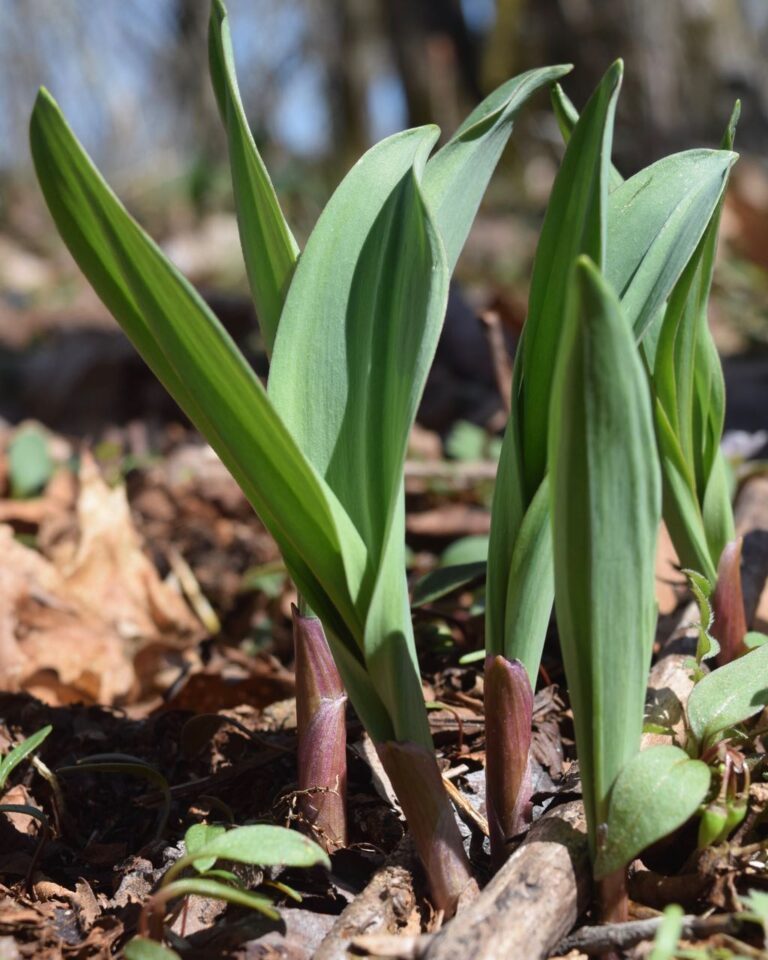
Potential of Princess Tree to Replace Tulip Poplar
Tulip Poplar (Liriodendron tulipifera) is a familiar member of plant communities throughout the Southeast. Noticing that the aggressively invasive Princess Tree (Paulownia tomentosa) is ecologically similar to Tulip Poplar, Hannah Dinkins decided to study the potential of the Princess Tree to replace it in Southern Appalachians forest communities. To do this, she used seedlings in burned and unburned research plots across natural light gradients. After the first year, she measured multiple parameters, such as water use, photosynthetic rates, and biomass, to compare the two species.
Hannah Dinkins, Western Carolina University
Photosynthesis, water use, and biomass allocation of Princess Tree (Paulownia tomentosa) and Tulip Poplar (Liriodendron tulipifera) first year seedlings across a light gradient and with or without prescribed fire. Advisor: Dr. Beverly Collins
link to thesis
Tulip Poplar (Liriodendron tulipifera) is a familiar member of plant communities throughout the Southeast. Noticing that the aggressively invasive Princess Tree (Paulownia tomentosa) is ecologically similar to Tulip Poplar, Hannah Dinkins decided to study the potential of the Princess Tree to replace it in Southern Appalachians forest communities. To do this, she used seedlings in burned and unburned research plots across natural light gradients. After the first year, she measured multiple parameters, such as water use, photosynthetic rates, and biomass, to compare the two species.
Hannah Dinkins, Western Carolina University
Photosynthesis, water use, and biomass allocation of Princess Tree (Paulownia tomentosa) and Tulip Poplar (Liriodendron tulipifera) first year seedlings across a light gradient and with or without prescribed fire. Advisor: Dr. Beverly Collins
link to thesis

Pollinators found on High-elevation Rocky Outcrops
Carson Ellis focused on her research on the pollination of plant communities found on remote high-elevation outcrops in the Southern Appalachians. These resource limited and isolated habitats, sparsely distributed and exposed to harsh weather conditions, present challenges to pollinators and researchers alike. Carson monitored these plant communities over time, collecting data related to flowering species and pollinators in order to assemble a floral visitation network. To strengthen the network connections, she also analyzed the pollen grains of captured pollinators. Understanding pollinator and plant assemblages of these rare outcrops, which often harbor endemic and imperiled plants, is critical information in protecting these fragile habitats.
Carson Ellis, Western Carolina University
Seasonal dynamics of floral visitation networks on high-elevation rock outcrops. Advisor: Dr. Beverly Collins
read full report
Carson Ellis focused on her research on the pollination of plant communities found on remote high-elevation outcrops in the Southern Appalachians. These resource limited and isolated habitats, sparsely distributed and exposed to harsh weather conditions, present challenges to pollinators and researchers alike. Carson monitored these plant communities over time, collecting data related to flowering species and pollinators in order to assemble a floral visitation network. To strengthen the network connections, she also analyzed the pollen grains of captured pollinators. Understanding pollinator and plant assemblages of these rare outcrops, which often harbor endemic and imperiled plants, is critical information in protecting these fragile habitats.
Carson Ellis, Western Carolina University
Seasonal dynamics of floral visitation networks on high-elevation rock outcrops. Advisor: Dr. Beverly Collins
read full report
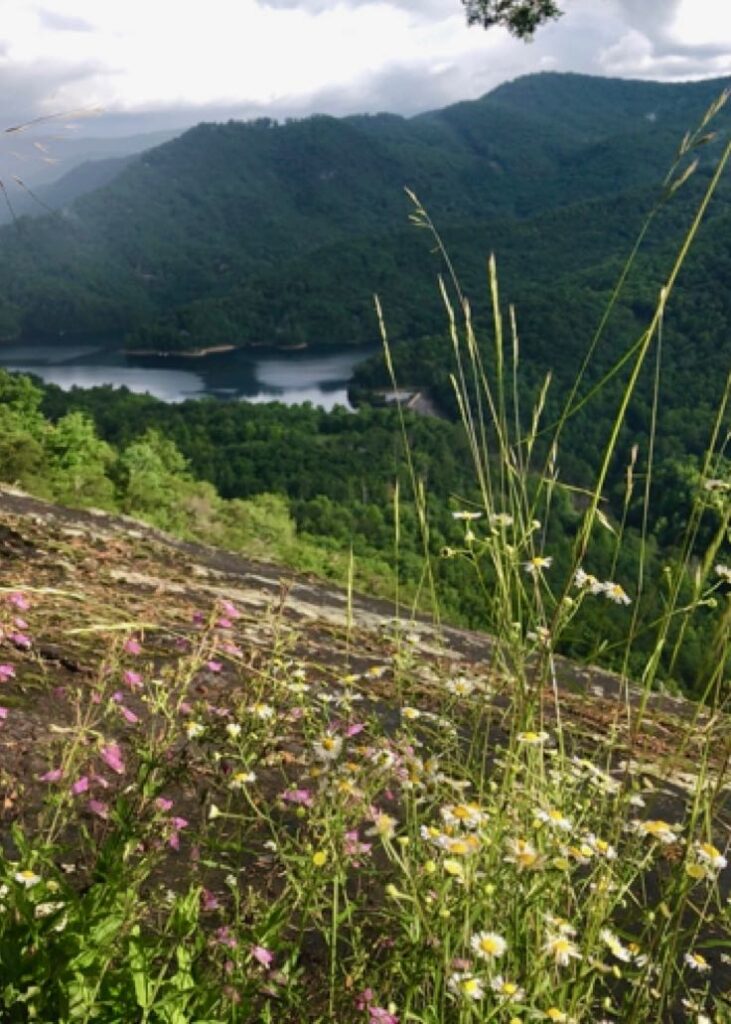
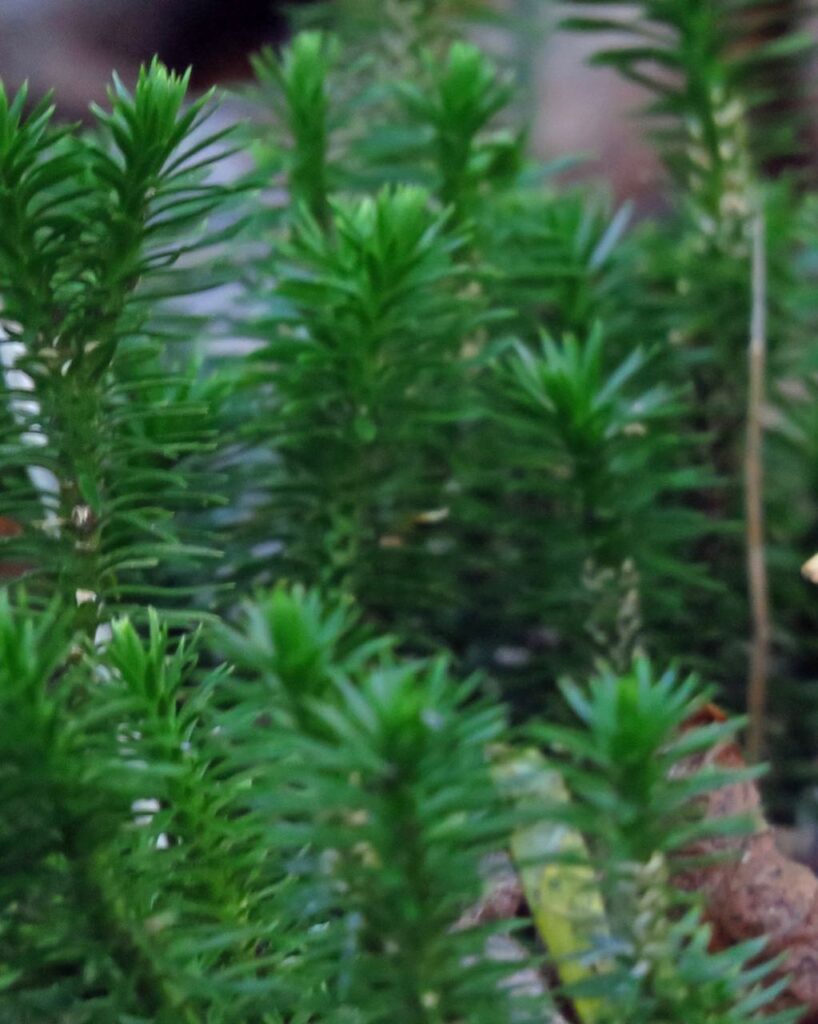
Hidden Secrets of Shining Clubmoss
Shining Clubmoss (Huperzia lucidula) is found in moist coniferous and mixed hardwood forests throughout North Carolina and may harbor a compound useful in the treatment of Alzheimer’s disease. Secondary metabolites have already been isolated from its Asian relative, Toothed Clubmoss, and are being used medicinally, leading to a decline in natural populations. Currently, neither clubmoss can be propagated in nurseries. Before interest in Shining Clubmoss here in North Carolina leads to overharvesting, Vanessa Gremler is keen to discover whether or not it harbors endophytic fungi that produce the medically relevant secondary metabolites. She is also interested in isolating the symbiotic endophytic fungi that live with Shining Clubmoss, as knowledge may allow others to propagate it in nursery settings.
Vanessa Gremler, Appalachian State University
Analysis of AChE Inhibitors in Huperzia lucidula endophytes. Advisor: Dr. Annkatrin Rose
Shining Clubmoss (Huperzia lucidula) is found in moist coniferous and mixed hardwood forests throughout North Carolina and may harbor a compound useful in the treatment of Alzheimer’s disease. Secondary metabolites have already been isolated from its Asian relative, Toothed Clubmoss, and are being used medicinally, leading to a decline in natural populations. Currently, neither clubmoss can be propagated in nurseries. Before interest in Shining Clubmoss here in North Carolina leads to overharvesting, Vanessa Gremler is keen to discover whether or not it harbors endophytic fungi that produce the medically relevant secondary metabolites. She is also interested in isolating the symbiotic endophytic fungi that live with Shining Clubmoss, as knowledge may allow others to propagate it in nursery settings.
Vanessa Gremler, Appalachian State University
Analysis of AChE Inhibitors in Huperzia lucidula endophytes. Advisor: Dr. Annkatrin Rose
Who Pollinates Venus Flytraps?
The Venus Flytrap (Dionaea muscipula) is one of the most charismatic plant species in the South, yet there has been only limited work on its pollination ecology, critical information in protecting the species. Laura Hamon continued her fieldwork she began in 2018 to document the various species that visit Venus Flytraps and empirically show which is the most efficient pollinator of the species. She also investigated seed set and the effects of supplemental prey (ie feeding them crickets) and/or pollen on seed numbers.
Laura Hamon, North Carolina State University
Pollination ecology of Venus flytrap (Dionaea muscipula). Advisor: Dr. Rebecca Irwin
read full report
link to thesis
Published paper: Hamon, et al. As prey and pollinators, insects increase reproduction and allow for outcrossing in the carnivorous plant Dionaea muscipula. American Journal of Botany. 2024; 111(2).
The Venus Flytrap (Dionaea muscipula) is one of the most charismatic plant species in the South, yet there has been only limited work on its pollination ecology, critical information in protecting the species. Laura Hamon continued her fieldwork she began in 2018 to document the various species that visit Venus Flytraps and empirically show which is the most efficient pollinator of the species. She also investigated seed set and the effects of supplemental prey (ie feeding them crickets) and/or pollen on seed numbers.
Laura Hamon, North Carolina State University
Pollination ecology of Venus flytrap (Dionaea muscipula). Advisor: Dr. Rebecca Irwin
read full report
link to thesis
Published paper: Hamon, et al. As prey and pollinators, insects increase reproduction and allow for outcrossing in the carnivorous plant Dionaea muscipula. American Journal of Botany. 2024; 111(2).
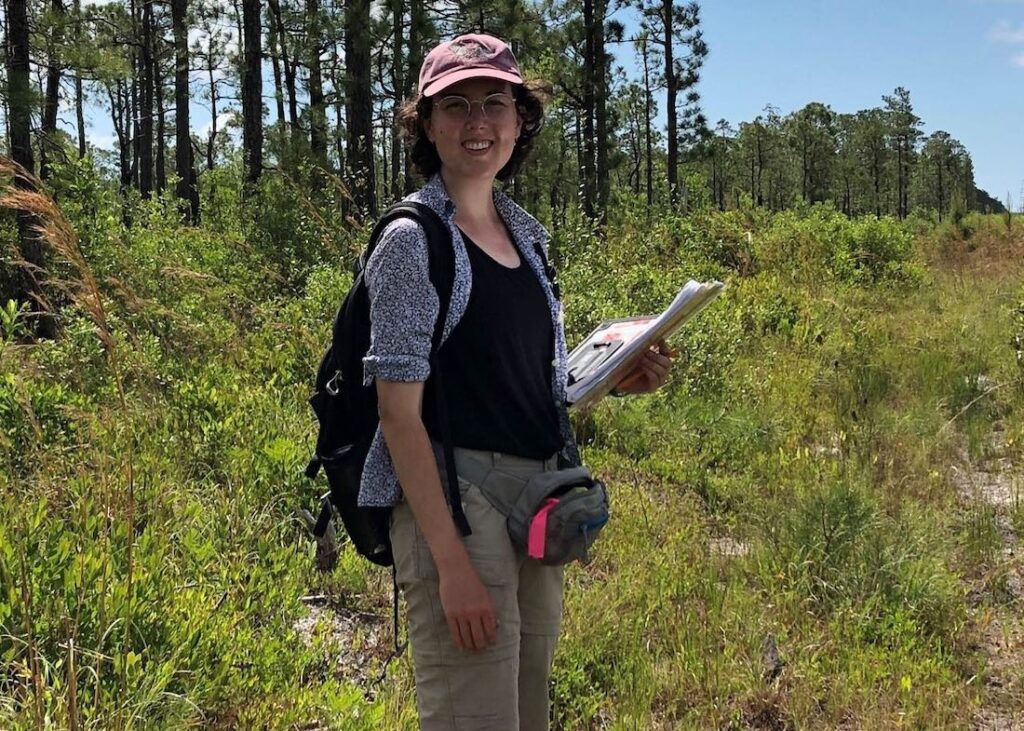
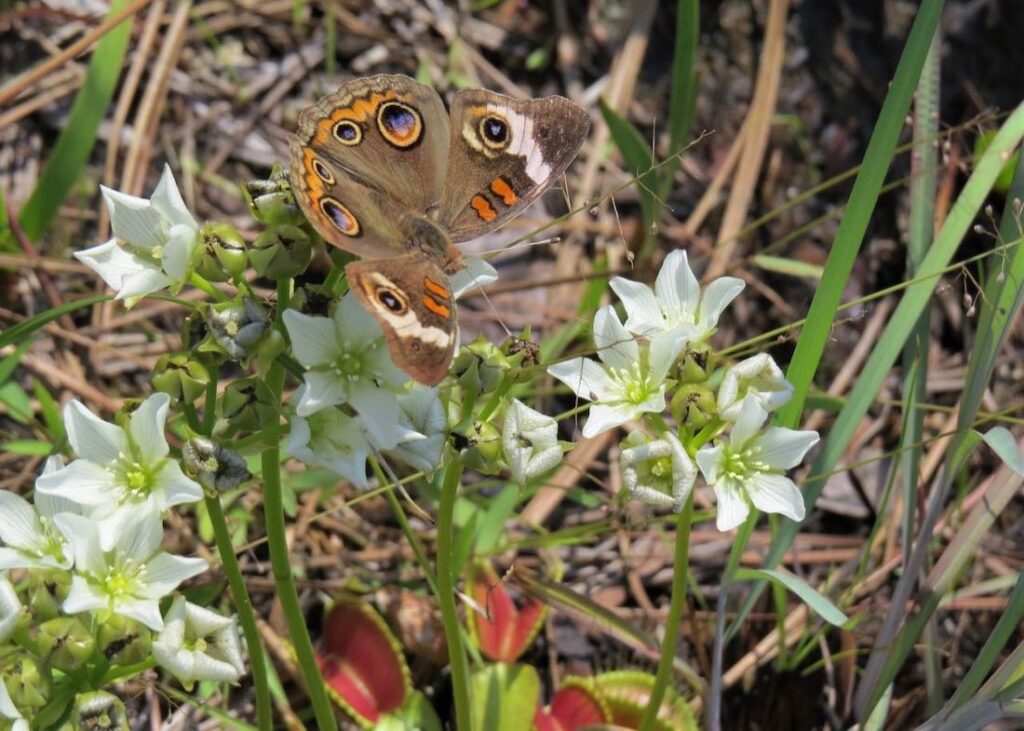
Rare Pitcher Plants and their Associated Flies
Peter Kann studied the relationship between well-known pitcher plants (Sarracenia) and the flies (Fletcherimyia) that use them as host plants. These flies feed on the pitcher plant’s captured prey, not on plant tissue. Pete determined which species of Fletcherimyia are associated with two rare, endangered pitcher plants, S. jonesii and S. oreophila.
Peter Kann, East Carolina University
One flew over the pitcher plant: updating ecological associations between pitcher plant flies and their carnivorous hosts. Advisor: Dr. Trip Lamb
link to thesis
Peter Kann studied the relationship between well-known pitcher plants (Sarracenia) and the flies (Fletcherimyia) that use them as host plants. These flies feed on the pitcher plant’s captured prey, not on plant tissue. Pete determined which species of Fletcherimyia are associated with two rare, endangered pitcher plants, S. jonesii and S. oreophila.
Peter Kann, East Carolina University
One flew over the pitcher plant: updating ecological associations between pitcher plant flies and their carnivorous hosts. Advisor: Dr. Trip Lamb
link to thesis
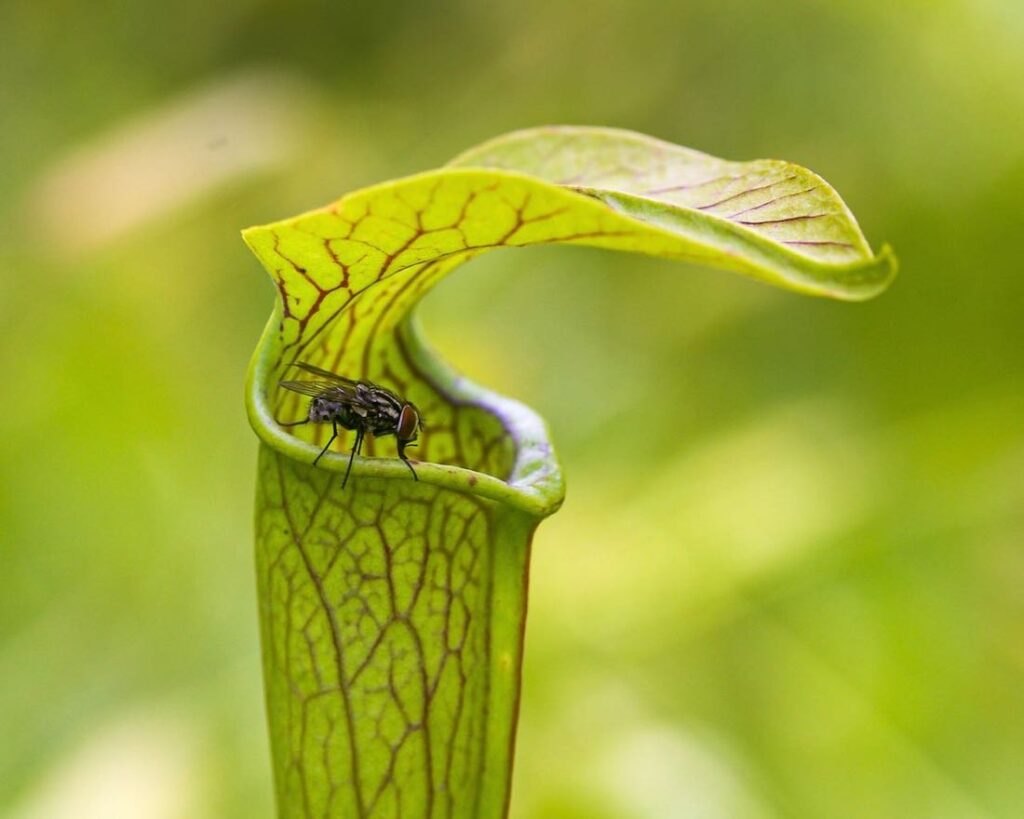
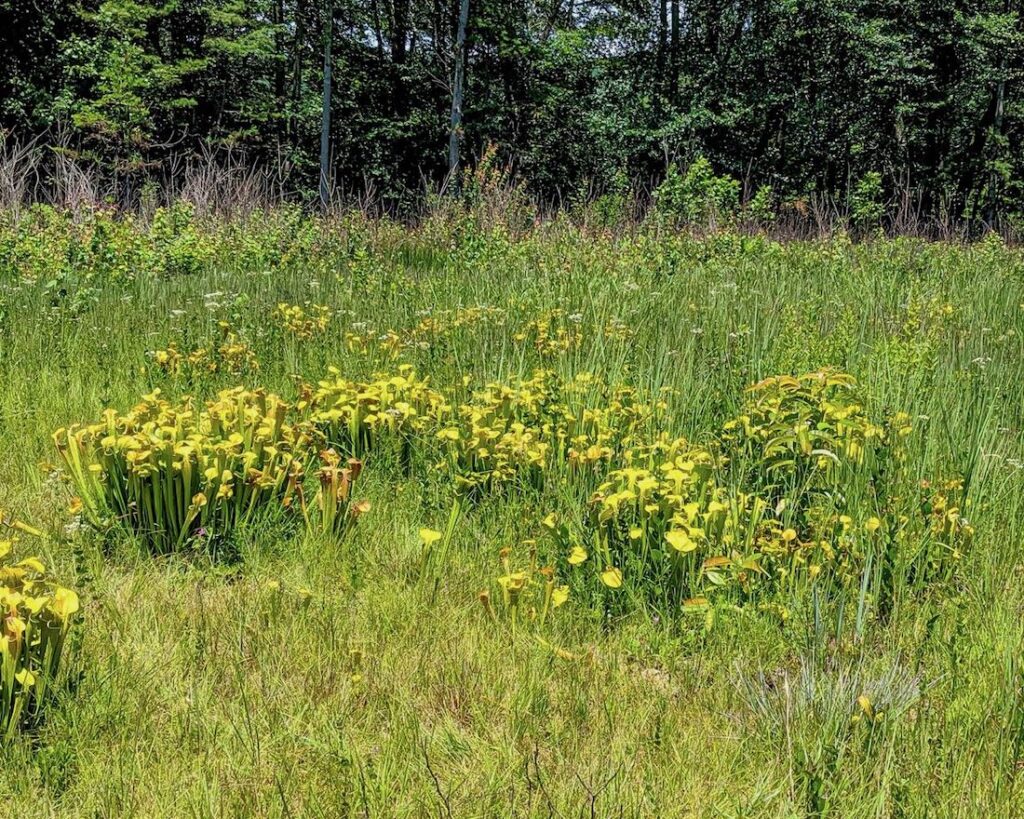
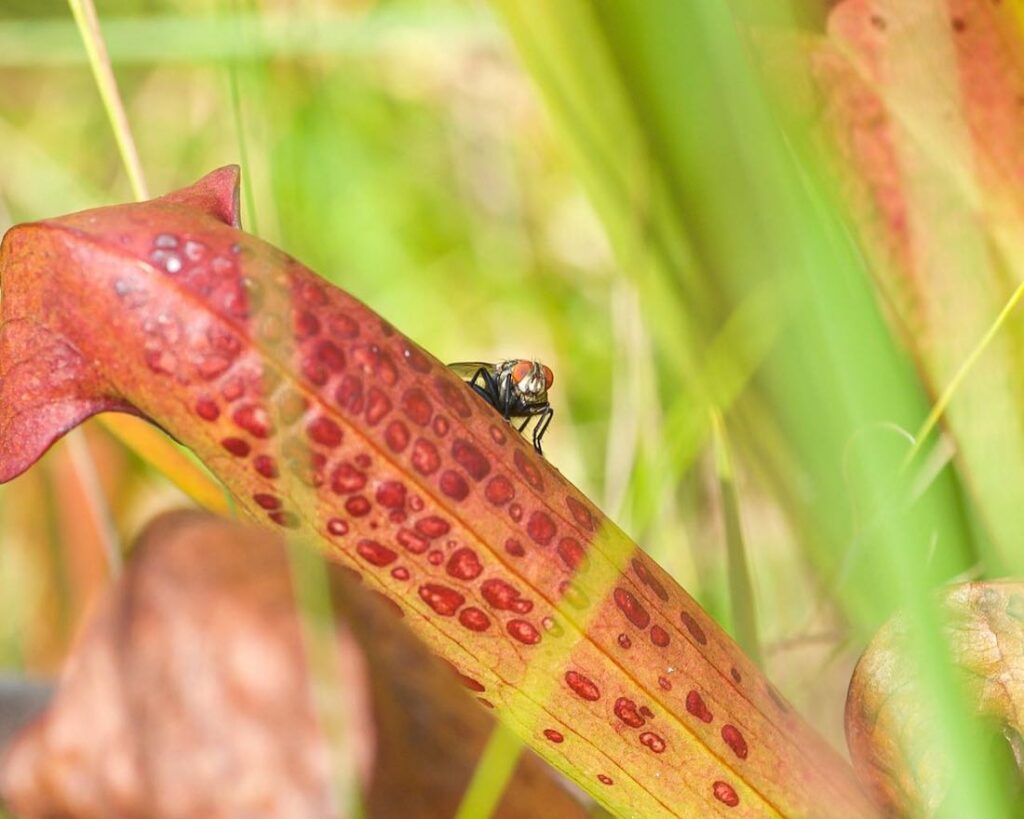
Stressful Living on Mountain Out-crops
Ryan O’Connell studied factors that could negatively impact populations of the imperiled Mountain Golden Heather (Hudsonia montana), which is found in only a few locations in the North Carolina mountains. Because plants often experience more than one environmental stressor at a time, Ryan examined both soil moisture levels and invasive species abundance simultaneously and separately in monitored plots. He measured survival, growth, and seed set of the Mountain Golden Heather and used the collected data to model predicted population changes.
Ryan O’Connell, Duke University
Effects of co-occurring anthropogenic stressors on Hudsonia montana, a critically imperiled North Carolina endemic. Advisor: Dr. William Morris
read full report
Ryan O’Connell studied factors that could negatively impact populations of the imperiled Mountain Golden Heather (Hudsonia montana), which is found in only a few locations in the North Carolina mountains. Because plants often experience more than one environmental stressor at a time, Ryan examined both soil moisture levels and invasive species abundance simultaneously and separately in monitored plots. He measured survival, growth, and seed set of the Mountain Golden Heather and used the collected data to model predicted population changes.
Ryan O’Connell, Duke University
Effects of co-occurring anthropogenic stressors on Hudsonia montana, a critically imperiled North Carolina endemic. Advisor: Dr. William Morris
read full report
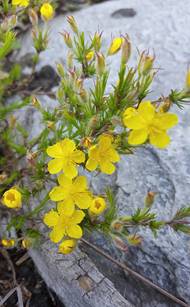
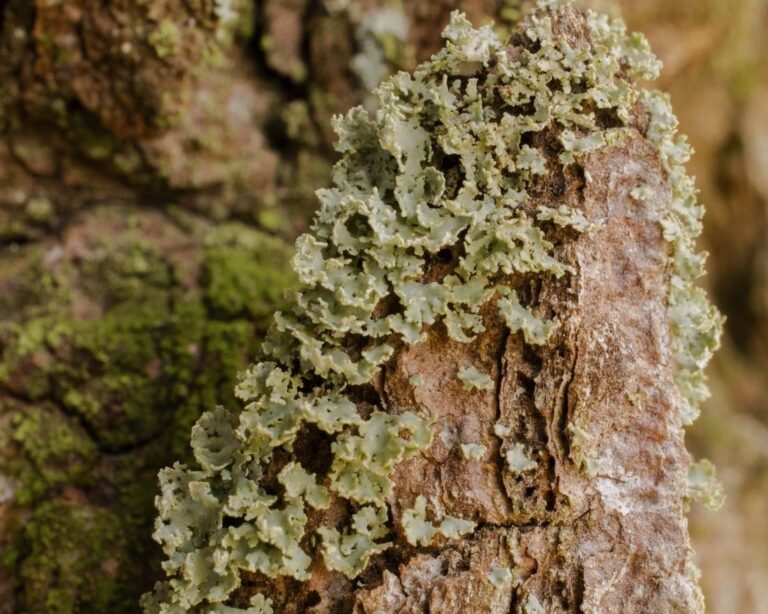
Bluff Mountain Lichen Community
As an undergraduate at AppState, Bubba Pfeffer studied the often overlooked but highly diverse lichen community. Their study site was Bluff Mountain, an area known to harbor several rare plant communities, where they sampled lichens on the trunks of endemic Carolina Hemlock trees. Because lichens are composite organisms composed of one or multiple species of fungi and algae or cyanobacteria, Bubba did not simply catalogue the species but also documented the more functional aspect of the intricate interactions and assemblages that compose the different lichen communities.
Bubba Pfeffer, Appalachian State University
Bluff Mountain lichen community descriptions. Advisors: Dr. Mike Madritch and Coleman McCleneghan
read full report
link to thesis
As an undergraduate at AppState, Bubba Pfeffer studied the often overlooked but highly diverse lichen community. Their study site was Bluff Mountain, an area known to harbor several rare plant communities, where they sampled lichens on the trunks of endemic Carolina Hemlock trees. Because lichens are composite organisms composed of one or multiple species of fungi and algae or cyanobacteria, Bubba did not simply catalogue the species but also documented the more functional aspect of the intricate interactions and assemblages that compose the different lichen communities.
Bubba Pfeffer, Appalachian State University
Bluff Mountain lichen community descriptions. Advisors: Dr. Mike Madritch and Coleman McCleneghan
read full report
link to thesis
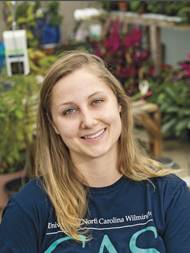
Genetic diversity of the Endangered Rough-leaved Yellow Loose-strife
Lysimachia asperulifolia (Rough-leaved Yellow Loose-strife), found only in the coastal plain of North and South Carolina, is an endangered species. Jessica Roach’s research focused on documenting the genetic diversity within nine known populations. The rhizomatous species appears to reproduce sexually at a low rate, so it is vital to understand how clonal the remaining populations are. Her data contributes to the management and protection of the species.
Jessica Roach, University of North Carolina at Wilmington
A comprehensive population genetics study of Lysimachia asperulifolia (Rough-leaved Yellow Loose-strife) throughout its natural range. Advisor: Dr. Darin Penneys
link to thesis
Lysimachia asperulifolia (Rough-leaved Yellow Loose-strife), found only in the coastal plain of North and South Carolina, is an endangered species. Jessica Roach’s research focused on documenting the genetic diversity within nine known populations. The rhizomatous species appears to reproduce sexually at a low rate, so it is vital to understand how clonal the remaining populations are. Her data contributes to the management and protection of the species.
Jessica Roach, University of North Carolina at Wilmington
A comprehensive population genetics study of Lysimachia asperulifolia (Rough-leaved Yellow Loose-strife) throughout its natural range. Advisor: Dr. Darin Penneys
link to thesis
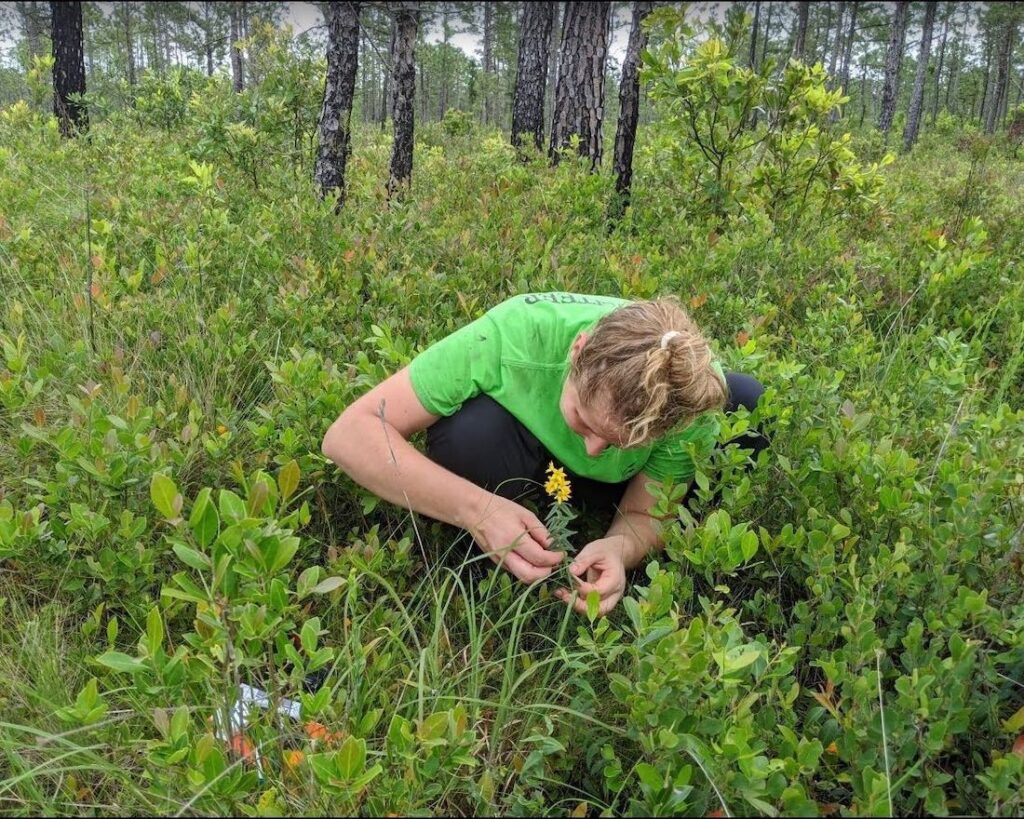
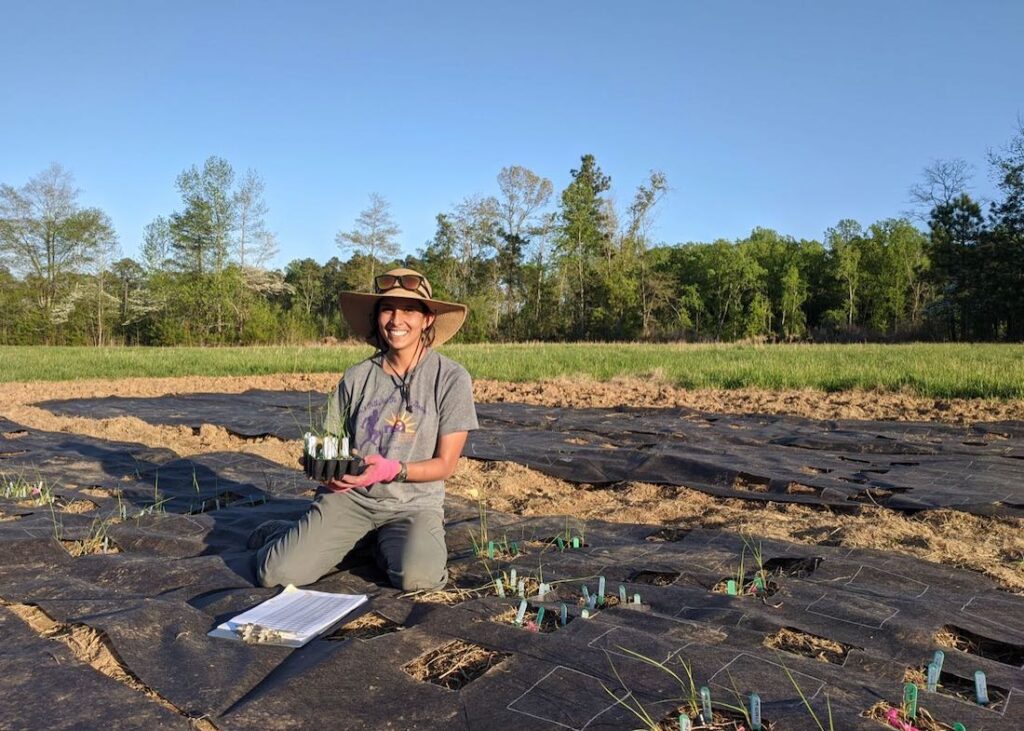
Grassland Competition under Simulated Climate Change Conditions
Anita Simha studied climate change impacts on native and non-native grasses. Their research explored how shifts in the timing of germination and flowering could favor one species over the other. Using an abandoned field, they simulated early germination of three grassland species in different combinations and documented how the competitive dominance of the grasses changed depending on which species germinated first. Because our warming planet can have unforeseen effects on the make-up of plant communities, studies such as Anita’s provide valuable information for future conservation efforts.
Anita Simha, Duke University
Impact of seasonal shifts and resource availability on competitive dominance of an exotic grass in a Piedmont grassland. Advisor: Dr. Justin Wright
read full report
Anita Simha studied climate change impacts on native and non-native grasses. Their research explored how shifts in the timing of germination and flowering could favor one species over the other. Using an abandoned field, they simulated early germination of three grassland species in different combinations and documented how the competitive dominance of the grasses changed depending on which species germinated first. Because our warming planet can have unforeseen effects on the make-up of plant communities, studies such as Anita’s provide valuable information for future conservation efforts.
Anita Simha, Duke University
Impact of seasonal shifts and resource availability on competitive dominance of an exotic grass in a Piedmont grassland. Advisor: Dr. Justin Wright
read full report
2019
Rock Climbing Routes and Sensitive Cliff Face Vegetation
Cliff systems can harbor unique, diverse plant communities, such as glacial relicts and endangered biota, and are dominated by stress-tolerant, often cryptic lichens, bryophytes, and vascular plants. Rock climbing is a major source of human disturbance to cliff ecosystems, but this effect is highly variable due to the unevenness of the rock surface. Preferred rock climbing routes could overlap with specific vegetation communities with detrimental impacts. Georgia Harrison quantified these impacts by conducting vegetation surveys of climbed and unclimbed cliff faces in the Linville Gorge Wilderness Area. She also created detailed fine mapping of cliff face topography, which she used to show how rock climbing routes could be disrupting ecological succession in lichen communities.
Georgia Harrison, Appalachian State University
Impact of rock-climbing disturbance and microhabitat characteristics on cliff face vegetation communities of the Linville Gorge Wilderness Area. Advisor: Dr. Michael Madritch
read full report
Published paper: Harrison et al. Rock-climbing shifts cliff-face vegetation community composition based on site characteristics. Applied Vegetation Science. 2022; 25.
Cliff systems can harbor unique, diverse plant communities, such as glacial relicts and endangered biota, and are dominated by stress-tolerant, often cryptic lichens, bryophytes, and vascular plants. Rock climbing is a major source of human disturbance to cliff ecosystems, but this effect is highly variable due to the unevenness of the rock surface. Preferred rock climbing routes could overlap with specific vegetation communities with detrimental impacts. Georgia Harrison quantified these impacts by conducting vegetation surveys of climbed and unclimbed cliff faces in the Linville Gorge Wilderness Area. She also created detailed fine mapping of cliff face topography, which she used to show how rock climbing routes could be disrupting ecological succession in lichen communities.
Georgia Harrison, Appalachian State University
Impact of rock-climbing disturbance and microhabitat characteristics on cliff face vegetation communities of the Linville Gorge Wilderness Area. Advisor: Dr. Michael Madritch
read full report
Published paper: Harrison et al. Rock-climbing shifts cliff-face vegetation community composition based on site characteristics. Applied Vegetation Science. 2022; 25.
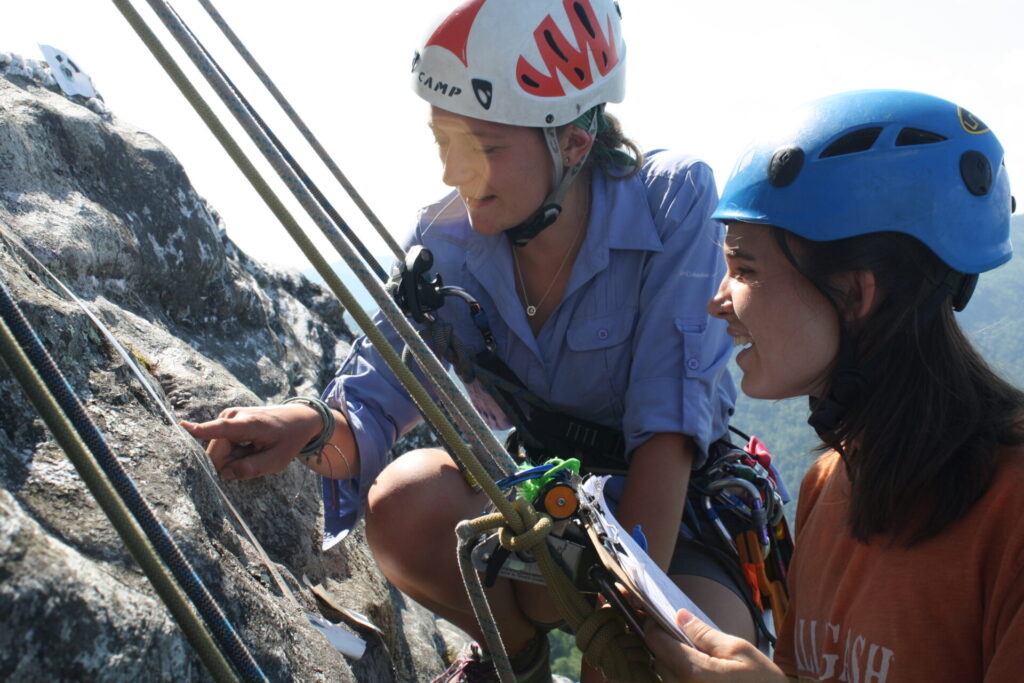
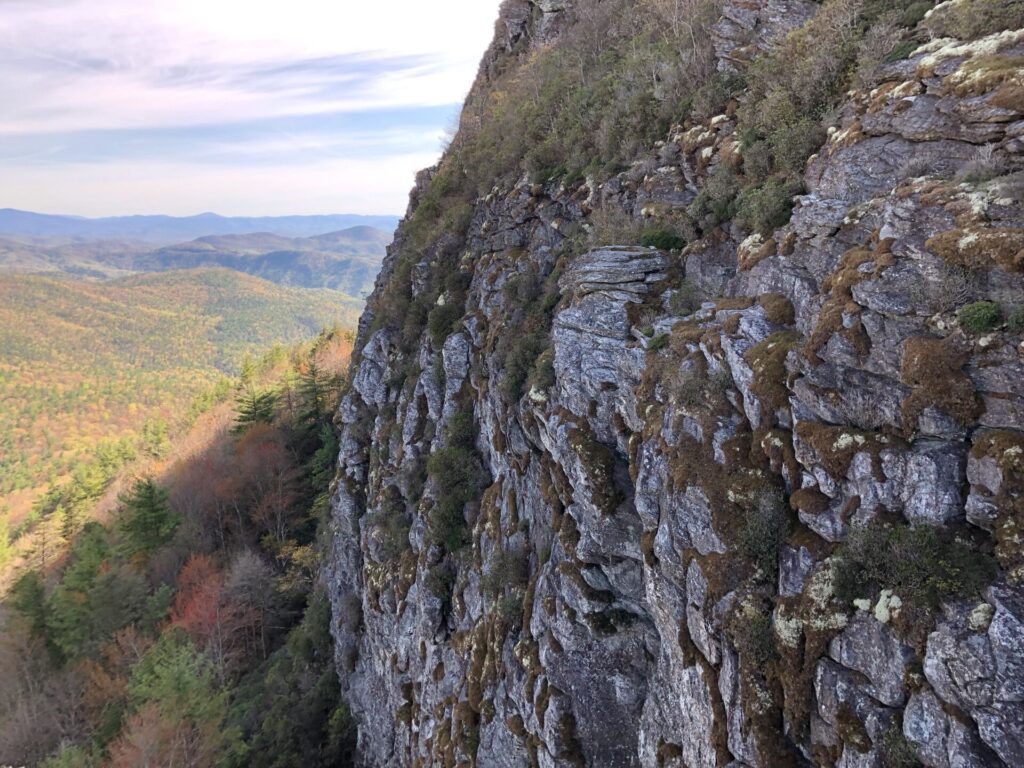
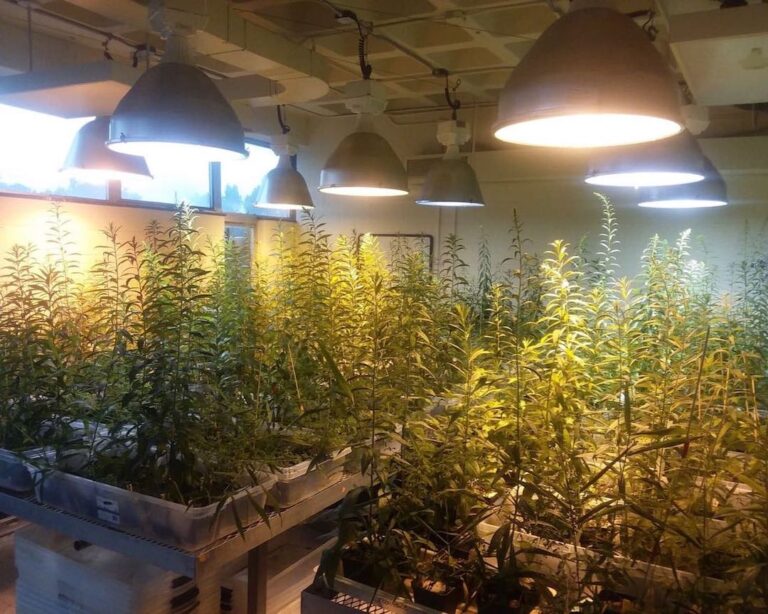
Published paper: Hodges and Goodwillie. Investigating the Role of Soil Legacy Effects in the Management of Lespedeza cuneata, an Invasive Legume. Natural Areas Journal. 2023; 43(2): 124-134.

How to control for Chinese Lespedeza when it is helping more Chinese Lespedeza grow
Invasive species are a threat to biodiversity and can be very difficult to control. Sometimes using herbicidal sprays are the only practical solution, although with negative consequences to the native flora. And while we are busy plotting above ground how to rid these aggressive exotics from our gardens and natural areas, below ground some invasives are busy changing the soil environment to their benefit. Matthew Hodges studied both of these issues using the invasive Chinese Lespedeza (Lespedeza cuneata) and three native species. Lespedeza formed more root nodules and grew to a larger size in soils previously occupied by Lespedeza, as opposed to soils not previously used by Lespedeza, indicating that the plant does alter the soil property in its favor. Matthew also found the native seedbank was less diverse and bountiful in sprayed soils, signaling that restoration efforts could be more successful by augmenting an area with native flora rather than simply relying on the seedbank. From his work, he also identified possible contenders for use in restoration post-removal of Lespedeza, such as Solidago altissima.
Matthew Hodges, East Carolina University
Investigating the role of soil legacy effects and community engagement in the management of Lespedeza cuneata, an invasive legume. Advisor: Carol Goodwillie
read full report
Invasive species are a threat to biodiversity and can be very difficult to control. Sometimes using herbicidal sprays are the only practical solution, although with negative consequences to the native flora. And while we are busy plotting above ground how to rid these aggressive exotics from our gardens and natural areas, below ground some invasives are busy changing the soil environment to their benefit. Matthew Hodges studied both of these issues using the invasive Chinese Lespedeza (Lespedeza cuneata) and three native species. Lespedeza formed more root nodules and grew to a larger size in soils previously occupied by Lespedeza, as opposed to soils not previously used by Lespedeza, indicating that the plant does alter the soil property in its favor. Matthew also found the native seedbank was less diverse and bountiful in sprayed soils, signaling that restoration efforts could be more successful by augmenting an area with native flora rather than simply relying on the seedbank. From his work, he also identified possible contenders for use in restoration post-removal of Lespedeza, such as Solidago altissima.
Matthew Hodges, East Carolina University
Investigating the role of soil legacy effects and community engagement in the management of Lespedeza cuneata, an invasive legume. Advisor: Carol Goodwillie
read full report

Surveying the remote Boone Fork headwaters in Grandfather Mountain State Park
The Boone Fork headwaters on the northeastern slope of Calloway Peak represent an area of high natural quality significance, yet there was little plant species or natural community data. The region is characterized by rugged terrain with few trails for access. Undaunted by the remoteness of the area, Ethan Hughes investigated the flora of this region. He documented 262 vascular plant species, 19 epipetric mosses, and 18 distinct natural communities. Twenty-four species were categorized as state-listed or federally listed. Ethan also researched the botanists who came before him. Using literature and herbarium database searches and personal communications, Ethan highlighted four scientists who played a role shaping the botanical knowledge of the region: Asa Gray, Rev. Moses Ashley Curtis, John K. Small and Amos A. Heller.
Ethan Hughes, Appalachian State University The flora of the Boone Fork headwaters within Grandfather Mountain State Park. Advisor: Zack Murrell
read full report
The Boone Fork headwaters on the northeastern slope of Calloway Peak represent an area of high natural quality significance, yet there was little plant species or natural community data. The region is characterized by rugged terrain with few trails for access. Undaunted by the remoteness of the area, Ethan Hughes investigated the flora of this region. He documented 262 vascular plant species, 19 epipetric mosses, and 18 distinct natural communities. Twenty-four species were categorized as state-listed or federally listed. Ethan also researched the botanists who came before him. Using literature and herbarium database searches and personal communications, Ethan highlighted four scientists who played a role shaping the botanical knowledge of the region: Asa Gray, Rev. Moses Ashley Curtis, John K. Small and Amos A. Heller.
Ethan Hughes, Appalachian State University The flora of the Boone Fork headwaters within Grandfather Mountain State Park. Advisor: Zack Murrell
read full report
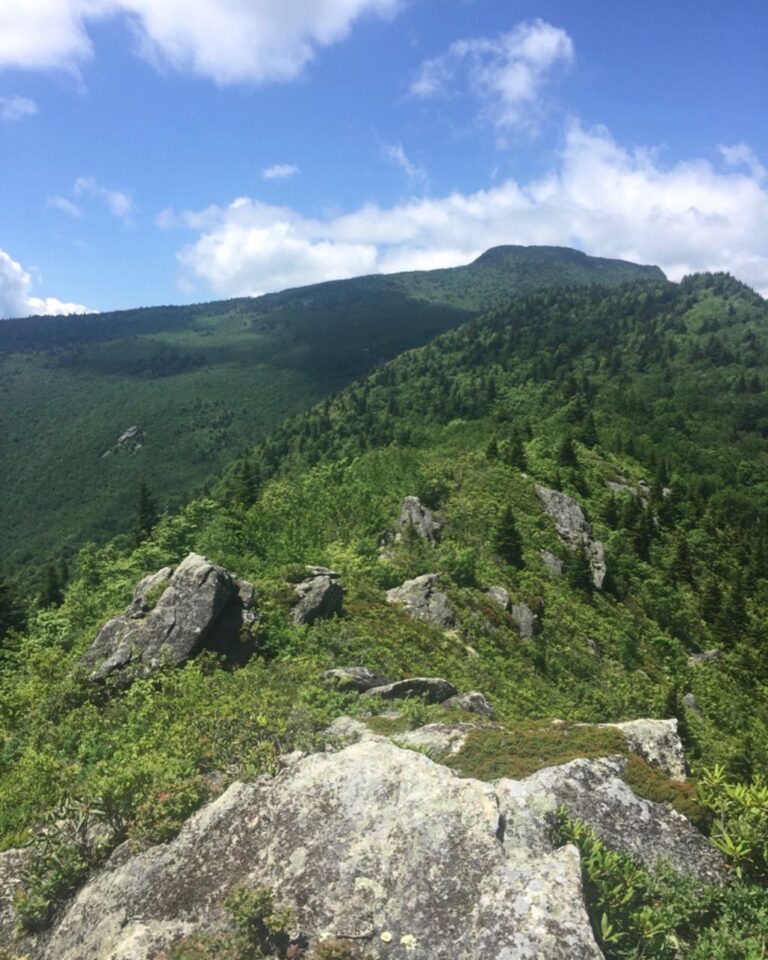
The Imperiled Sandhills Milkvetch
Sandhills Milkvetch (Astragalus michauxii) is a rare Southeastern United States endemic found in dry sandhills scrub and pine oak scrub communities within the Sandhills region of North Carolina, South Carolina, and Georgia. There are 46 known populations in North Carolina, although researchers have documented other populations that have disappeared. Additionally, most existing populations have only 20 individuals or less. Low reproductive fruit set contributes to its fragile state. To better protect this imperiled species, Michael Kunz spent two field seasons studying the reproductive ecology of the A. michauxii. To document pollination events and to identify pollinators, he collected over 800 hours of video from time-lapse cameras and found infrequent pollination visits. Hand pollinating of 100s of flowers and counting fruit set revealed not only low pollen amounts, but also that A. michauxii is self-incompatible.
Michael Kunz, University of North Carolina at Chapel Hill Population ecology of Astragalus michauxii, a rare Southeastern US endemic species. Advisor: Dr. Alan Weakley
read full report
Sandhills Milkvetch (Astragalus michauxii) is a rare Southeastern United States endemic found in dry sandhills scrub and pine oak scrub communities within the Sandhills region of North Carolina, South Carolina, and Georgia. There are 46 known populations in North Carolina, although researchers have documented other populations that have disappeared. Additionally, most existing populations have only 20 individuals or less. Low reproductive fruit set contributes to its fragile state. To better protect this imperiled species, Michael Kunz spent two field seasons studying the reproductive ecology of the A. michauxii. To document pollination events and to identify pollinators, he collected over 800 hours of video from time-lapse cameras and found infrequent pollination visits. Hand pollinating of 100s of flowers and counting fruit set revealed not only low pollen amounts, but also that A. michauxii is self-incompatible.
Michael Kunz, University of North Carolina at Chapel Hill Population ecology of Astragalus michauxii, a rare Southeastern US endemic species. Advisor: Dr. Alan Weakley
read full report
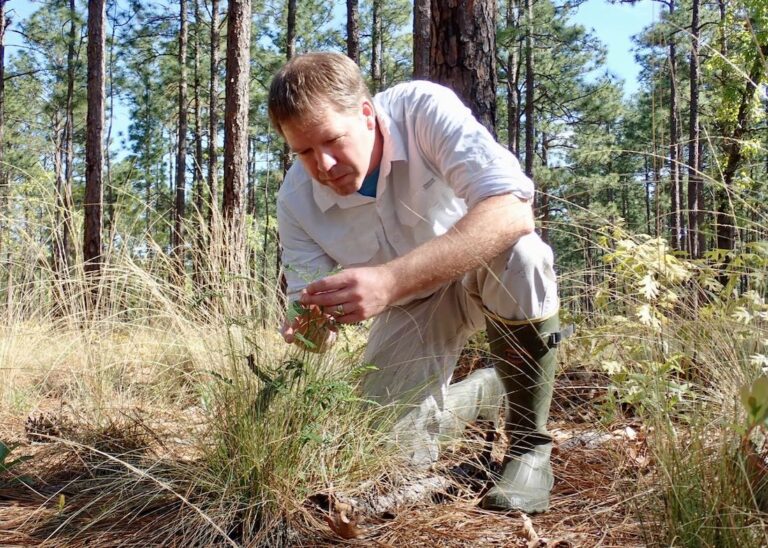
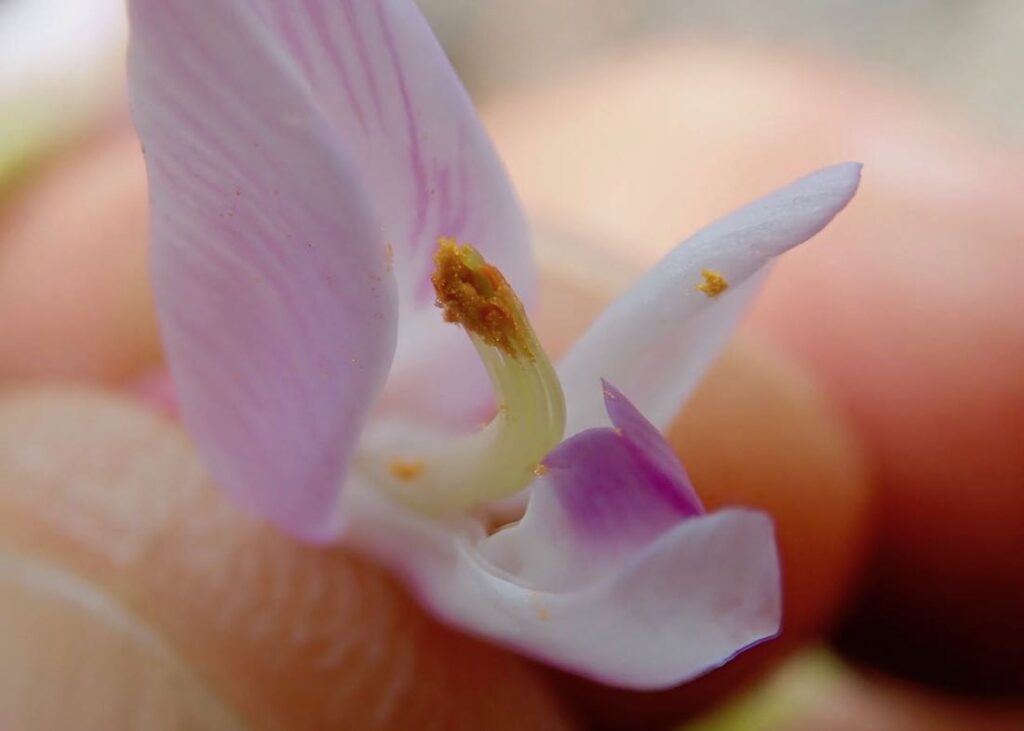
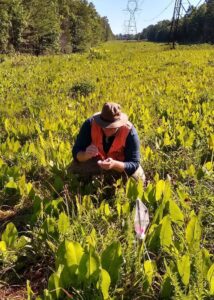
Population Ecology of Echinacea laevigata
Smooth purple coneflower (Echinacea laevigata) is a highly charismatic member of the Northern Prairie Barren plant community, a rare plant community in North Carolina. The largest population in the world is found in Granville County at Picture Creek Diabase Barrens. There, populations of the Smooth purple coneflower are found in two different habitats: a power line right-of-way and adjacent woodlands. As Smooth purple coneflower is self-incompatible, Greg Wilson wondered whether or not the two populations share pollinators and if there is gene flow between the two habitats. He placed fluorescent pollen tracking dye on the flower heads, and documented the pollinator visits by visualizing the plants in the evening with UV light. He also marked and released butterfly pollinators to see if they visited both habitats. To further study gene flow between the populations, Greg also conducted controlled crosses using pollen from the two habitats.
Greg Wilson, North Carolina State University
Pollination ecology and local adaptation of Echinacea laevigata (Asteraceae) in woodland and open microhabitats at Picture Creek Diabase Barrens. Advisor: Alexander Krings
read full report
Smooth purple coneflower (Echinacea laevigata) is a highly charismatic member of the Northern Prairie Barren plant community, a rare plant community in North Carolina. The largest population in the world is found in Granville County at Picture Creek Diabase Barrens. There, populations of the Smooth purple coneflower are found in two different habitats: a power line right-of-way and adjacent woodlands. As Smooth purple coneflower is self-incompatible, Greg Wilson wondered whether or not the two populations share pollinators and if there is gene flow between the two habitats. He placed fluorescent pollen tracking dye on the flower heads, and documented the pollinator visits by visualizing the plants in the evening with UV light. He also marked and released butterfly pollinators to see if they visited both habitats. To further study gene flow between the populations, Greg also conducted controlled crosses using pollen from the two habitats.
Greg Wilson, North Carolina State University
Pollination ecology and local adaptation of Echinacea laevigata (Asteraceae) in woodland and open microhabitats at Picture Creek Diabase Barrens. Advisor: Alexander Krings
read full report
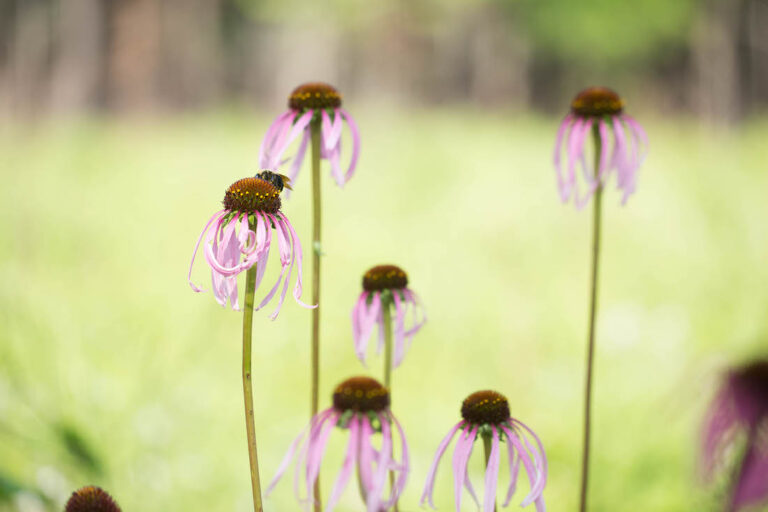
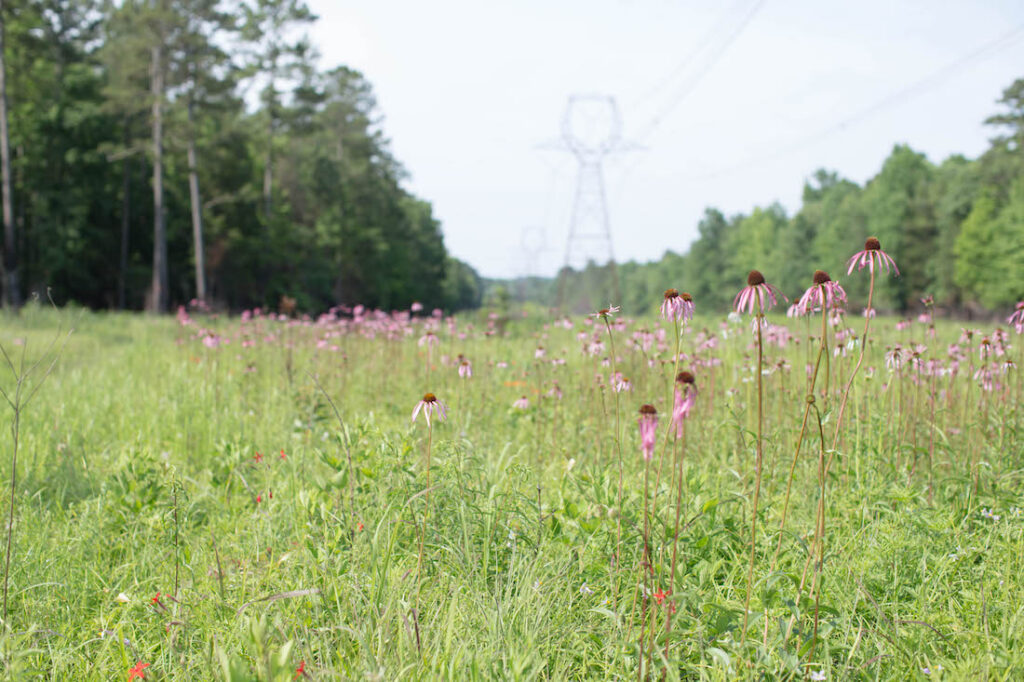
David De La Mater, Duke University
Effects of elevated temperatures and eutrophication on plant-herbivore interactions and impacts on a salt marsh foundation species. Advisor: Justin Wright
Effects of elevated temperatures and eutrophication on plant-herbivore interactions and impacts on a salt marsh foundation species. Advisor: Justin Wright
2018
Katherine Culatta, North Carolina State University
Taxonomy, population genetics, and status assessment of Nuphar sagittifolia (Nymphaeaceae) Advisor: Dr. Alexander Krings
Published paper: Culatta, et al. Clarifying taxonomic boundaries in Nuphar sagittifolia (Nymphaeaceae): insights from morphology and population genetic diversity. Castanea. 2022; 87:81-104.
Laura Hamon, North Carolina State University
Pollination ecology of Venus Flytrap (Dionaea muscipula). Advisor: Dr. Rebecca Irwin
Published paper: Hamon, et al. Pollination ecology and morphology of Venus Flytrap in sites of varying time since last fire. Annals of the Entomological Society of America. 2019; 112:141–149.
Bryan Piatkowski, Duke University
Systematics, molecular evolution, and functional trait variation in the Sphagnum magellanicum (Sphagnaceae) species complex. Advisor: Dr. Jon Shaw
Published paper: Shaw, et. al. Phylogenomic structure and speciation in an emerging model: the Sphagnum magellanicum complex (Bryophyta). New Phytologist. 2022; 236:1497-1511.
Ellen Quinlan, Western Carolina University
Phylogenetic history and variation in water-use efficiency of mountain and coastal populations of Kalmia buxifolia. Advisor: Dr. Katherine Mathews
Published paper: Quinlan, et al. Phylogenetic divergence and ecophysiological variation in the disjunct Kalmia buxifolia (Sand-myrtle, Ericaceae). Systematic Botany. 2020; 900-912.
Marietta Shattelroe, Appalachian State University
Genetic diversity of Geum geniculatum. Advisor: Dr. Matt C. Estep
Published paper: Shattelroe, et al. Genetic diversity and population structure of the forgotten Geum, Geum geniculatum Michx. Castanea. 2021; 85:404-416.
Alexandria Szakacs, North Carolina State University
Reconstructing the vegetation history of a Piedmont prairie remnant using soil phytoliths. Advisor: Dr. Alexander Krings
Published paper: Szakacs, et al. Shade-tolerance classification of the upland herbaceous flora of the Carolina and Virginia Piedmont. The American Midland Naturalist. 2022;187: 113-147.
Taxonomy, population genetics, and status assessment of Nuphar sagittifolia (Nymphaeaceae) Advisor: Dr. Alexander Krings
Published paper: Culatta, et al. Clarifying taxonomic boundaries in Nuphar sagittifolia (Nymphaeaceae): insights from morphology and population genetic diversity. Castanea. 2022; 87:81-104.
Laura Hamon, North Carolina State University
Pollination ecology of Venus Flytrap (Dionaea muscipula). Advisor: Dr. Rebecca Irwin
Published paper: Hamon, et al. Pollination ecology and morphology of Venus Flytrap in sites of varying time since last fire. Annals of the Entomological Society of America. 2019; 112:141–149.
Bryan Piatkowski, Duke University
Systematics, molecular evolution, and functional trait variation in the Sphagnum magellanicum (Sphagnaceae) species complex. Advisor: Dr. Jon Shaw
Published paper: Shaw, et. al. Phylogenomic structure and speciation in an emerging model: the Sphagnum magellanicum complex (Bryophyta). New Phytologist. 2022; 236:1497-1511.
Ellen Quinlan, Western Carolina University
Phylogenetic history and variation in water-use efficiency of mountain and coastal populations of Kalmia buxifolia. Advisor: Dr. Katherine Mathews
Published paper: Quinlan, et al. Phylogenetic divergence and ecophysiological variation in the disjunct Kalmia buxifolia (Sand-myrtle, Ericaceae). Systematic Botany. 2020; 900-912.
Marietta Shattelroe, Appalachian State University
Genetic diversity of Geum geniculatum. Advisor: Dr. Matt C. Estep
Published paper: Shattelroe, et al. Genetic diversity and population structure of the forgotten Geum, Geum geniculatum Michx. Castanea. 2021; 85:404-416.
Alexandria Szakacs, North Carolina State University
Reconstructing the vegetation history of a Piedmont prairie remnant using soil phytoliths. Advisor: Dr. Alexander Krings
Published paper: Szakacs, et al. Shade-tolerance classification of the upland herbaceous flora of the Carolina and Virginia Piedmont. The American Midland Naturalist. 2022;187: 113-147.
2017
Ashley M. Dow, East Carolina University
Native plants as viable pollinator habitat on solar panel farms in eastern North Carolina. Advisor: Dr. Claudia Jolls
Native plants as viable pollinator habitat on solar panel farms in eastern North Carolina. Advisor: Dr. Claudia Jolls
2016
Andrea Thompson, North Carolina State University
Solidago spithamaea: Study in population viability. Advisor: Dr. Gary B. Blank
Rachel Kelsy Stillwell, Western Carolina University
Microsatellite marker optimization and gene flow analysis between species of the erectum complex of Trillium. Advisor: Dr. Katherine Mathews
Solidago spithamaea: Study in population viability. Advisor: Dr. Gary B. Blank
Rachel Kelsy Stillwell, Western Carolina University
Microsatellite marker optimization and gene flow analysis between species of the erectum complex of Trillium. Advisor: Dr. Katherine Mathews
2015
Michelle D’Aguillo, Duke University
Germination ecology of two southern Appalachian natives, Houstonia caerulea and H. serpyllifolia (Rubiaceae). Advisor: Dr. Kathleen Donohue
Rebecca M. Dalton, Duke University
Changes to flowering phenology in native wildflower communities in North Carolina. Advisor: Dr. William Morris
Gary Perlmutter, North Carolina State University
Traffic emissions effects on forest lichen communities in North Carolina. Advisor: Dr. Gary Blank
Germination ecology of two southern Appalachian natives, Houstonia caerulea and H. serpyllifolia (Rubiaceae). Advisor: Dr. Kathleen Donohue
Rebecca M. Dalton, Duke University
Changes to flowering phenology in native wildflower communities in North Carolina. Advisor: Dr. William Morris
Gary Perlmutter, North Carolina State University
Traffic emissions effects on forest lichen communities in North Carolina. Advisor: Dr. Gary Blank
2014
Reneé Fortner, East Carolina University
The reproductive ecology of the federally endangered Cooley’s Meadowrue (Thalictrum cooleyi Ahles). Advisor: Dr. Claudia Jolls
Kipp Callahan, North Carolina State University
The vascular flora of Pondberry Bay (Sampson County, NC). Advisor: Dr. Alexander Krings
Nathan Howell, North Carolina State University
The vascular flora of the natural lake shoreline community of Carolina bays in the Carolina flatwoods and Mid-Atlantic floodplains and low terraces ecoregions (Bladen and Columbus Counties, North Carolina). Advisor: Dr. Alexander Krings
The reproductive ecology of the federally endangered Cooley’s Meadowrue (Thalictrum cooleyi Ahles). Advisor: Dr. Claudia Jolls
Kipp Callahan, North Carolina State University
The vascular flora of Pondberry Bay (Sampson County, NC). Advisor: Dr. Alexander Krings
Nathan Howell, North Carolina State University
The vascular flora of the natural lake shoreline community of Carolina bays in the Carolina flatwoods and Mid-Atlantic floodplains and low terraces ecoregions (Bladen and Columbus Counties, North Carolina). Advisor: Dr. Alexander Krings
2013
Amanda Faucette, North Carolina State University
The Vascular Flora and Soils of Buxton Woods (Dare County, NC). Advisor: Dr. Alexander Krings
Kyle Palmquist, University of North Carolina at Chapel Hill
The joint effects of drought and reduced fire frequency on native orchids in the Green Swamp Preserve, North Carolina. Advisor: Dr. Alan Weakley
The Vascular Flora and Soils of Buxton Woods (Dare County, NC). Advisor: Dr. Alexander Krings
Kyle Palmquist, University of North Carolina at Chapel Hill
The joint effects of drought and reduced fire frequency on native orchids in the Green Swamp Preserve, North Carolina. Advisor: Dr. Alan Weakley